Don't wanna be here? Send us removal request.
Text
Homeward Bound
18-19/05/2018: It was a fairly early one this morning. We were to head back to Australia after lunch so we needed to get sorted starting with breakfast. By eight Jo, Cecelia and Shane were in the café on the corner, Oppio, and ordering bacon and eggs. We didn't frequent this place much as its atmosphere wasn't our scene where as La Biga was. Oldies tend to like quiet ones. La Biga however, opened until late so they didn't reopen until late.
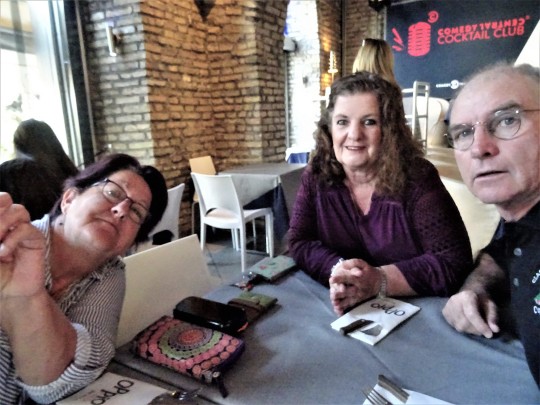
Waiting for breakfast
After breakfast, last minute packing took us up until the pickup time by old mate in his swanky Lancia. By leaving around ten and assuming he would make the airport by eleven, we would be there three hours early and right on check in.
Once checked in and queuing for the security check, we noticed that Interpol were hanging around for some reason or someone so we reckoned that they may have been waiting for Thomas to arrive and we made a point of it. He didn't bother paying his speeding fine from almost a month ago and we emphasised to him that it was he that they were looking for. He knew that we were taking the piss but he didn't seem overly confident as he made his way through the check point.
Once through security we had to get to Boarding Area which seemed to be a satellite terminal, separated from the main complex. Our mode of travel, like we had a choice, was a sky train. This would take us out and deliver us to our awaiting Thai Jumbo. From there it was a simple process of the usual waiting and queuing. Before long and after an uneventful journey to Bangkok, we were waiting to board again.
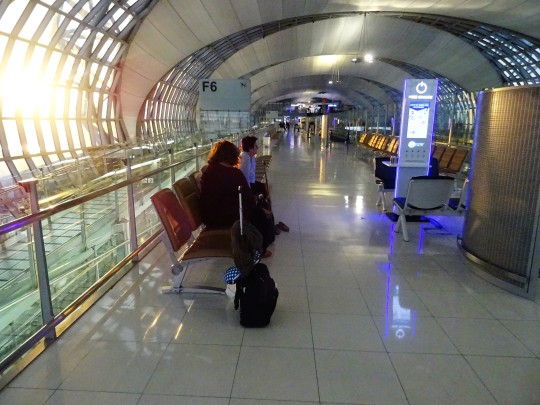
Waiting at Suvarnabhumi Airport
From Suvarnabhumi it was again no issues, except for the cramped conditions. Arriving in Sydney late afternoon ruled out training it straight back to Newcastle, making an overnight stay at Rydges necessary. We were all booked into a family room. Jo and Shane in the bedroom and Cec and the boys out in the lounge area. Upon seeing the arrangements Cec remarked, "I love you boys but I have had enough of close living." With that she headed to reception and booked her own room.
The next morning we were on the train and by early afternoon at home.
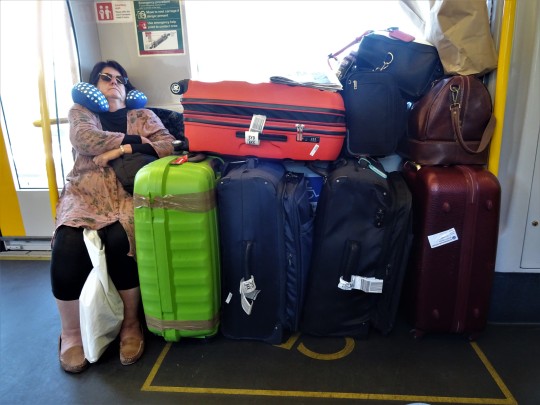
Cecilia, Guardian of the Luggage
Twenty nine days, five flights and a private water taxi, several vaporettos, a tram and two hire cars to fit us all. Dozens of kilometres walked on the various tours. A long coach ride and tight schedules. The emotion of the ANZAC Day dawn service, a few hiccups (otherwise referred to as "Shane's cockups" by Cecilia), some stressful but nothing that couldn't be sorted. We came through this trip with many good and long lasting memories.
Postscript regarding Cecilia
From the very moment that we invited her along with us, she was keen. Not a moment of hesitation, she promptly committed and planned how to fund it. From memory giving up the durries was part of the plan at some point. Then, when we planned the itinerary we were one as a team, although very reliant on Shane not to fuck anything up, which he did of course. But it's important not to let things get to you if something goes awry. All of the fuckups on this holiday only cost a few hundred dollars, which in the big picture was nothing. We did everything we wanted and had a great time.
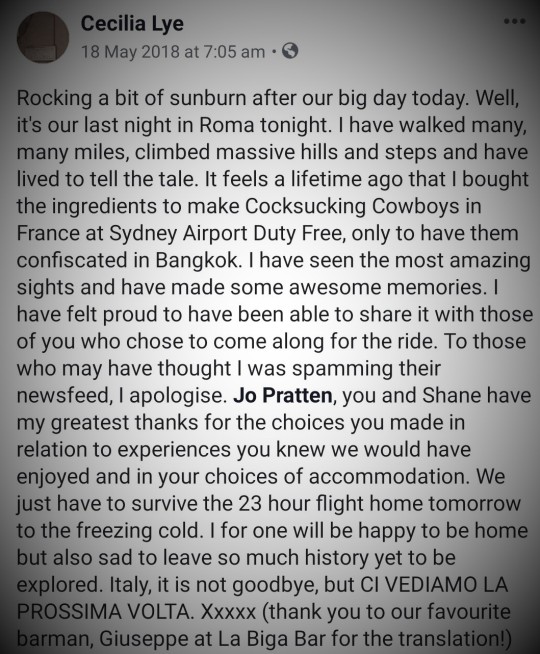
As for Cecilia's performance while we were away, in hindsight, it was pretty good. Her appetite for everything was fantastic, culture, knowledge, travel, but most of all her appetite for pizza and wine out done all. Who was to know that what we thought was lethargy when walking the streets was not laziness or her showing her age but attributable to the hideous disease that was yet to be diagnosed. Two months after returning to Australia, the pain in Cec's back, that flared up at Trevi Fountain, continued and had spread to her tummy. With weight loss occurring, she headed to the doctors for some treatment. By August we were to discover she was riddled with cancer. Never one to sugar coat anything and her wry sense of humour, she teased Shane by telling him "See! I had a good reason for walking so slow all the time. I was dragging around a bag full of cancer cells." Less than a year after our amazing holiday she was gone.
Cec, we know you are sorely missed by your family, and indeed your extended family. We were lucky to have spent such an eventful and happy month with you during now what seems such a long time ago.
Vale Cecilia.
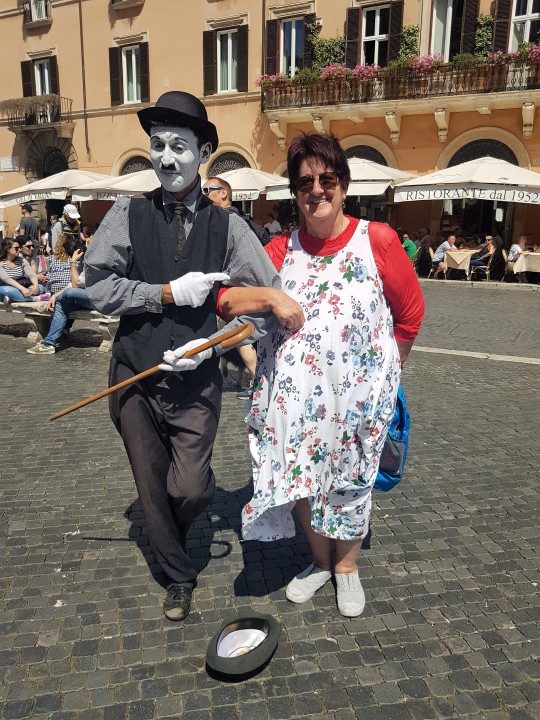
Vale Cec
0 notes
Text
Herculaneum & Pompei
17/05/2018: We left this early morning to walk to Roma termini, needing to catch the seven twenty Freccia Rossa to Naples, followed by the first available Circumvesuviana train to Pompei Scavi.
Jumping straight on the train, Cec questioned whether we were on the correct one. "Yes" was Jo's reply, pointing out the board informing travelers of the final destination, Napoli. Then the thought crossed Jo's mind, "why did we have reserved seats when there were no seat numbers?" Shane got off and looked at the info board back in the main part of the station. Damn, Cecilia was right! We were on the regional train to Naples not the fast train. It was a mad dash to get off the train and scurry the seven platforms to get on the correct train. Apart from the big money difference there was a huge time difference between the two trains, one hour compared to three hours! Thankfully we made the change of trains with five minutes to spare, sat back in somewhat more comfort and speed than the regional train and enjoyed the ride.

Our fastest trip in Italy. Made it to 300
The arrival of the train at Napoli Centrale was smooth and on time, an hour and five minutes after departure. Following the signs to Garibaldi Station where the rattlers would take us south caused some confusion but after a short delay we found the ticket booth. Five return tickets and we were heading down to the platform. There were only two trains that travelled in the direction of Pompei, the first was to Sarno, which veered left at Barra and went around the eastern side of Vesuvius and the second, which was ours, to Sorrento. The trip was a half hour long and was pretty packed. Standing room only. There were plenty of locals getting on and off each stop which made it awkward at times standing in the carriage entrance. We managed, and by around ten o'clock joined the queue for tickets and audio guides at Pompei. The rest was easy.
We estimated that we could see what we wanted by two, an hour back to Herculaneum, an hour there and back to Napoli Centrale. This would give us plenty of time to catch the seven o'clock train back to Rome.

Entry point to the ruins
Located on a plateau of Vesuvian lava flow and overlooking the valley of the River Sarno, the ancient city of Pompei, dating back many centuries B.C., thrived from the produce of the fertile plains that are today part of the Campania region. During Samnite rule that commenced during the late fifth century B.C., Pompei was highly urbanised, refortified and dependant on Nocera, the largest city in the area. The movement of the Samnites unsettled political order resulting in Rome intervening in southern Italy, with military campaigns during the Social War leading to Roman dominance over the entire region. A few hundred years on and after becoming an ally of the Roman res publica, Pompei along with other Italic communities rebelled, demanding equity with Rome regarding social and political equality. This resulted in Lucius Cornelius Sulla and his centurions besieging the joint, forcing Pompei's surrender and subsequent creation of a colony by the name of Cornelia Veneria Pompeianorum. Once founded, Roman money moved in with private and public building popping up everywhere, embellished over the following decades under the rule of Augustus and Tiberius.
This all come unstuck a few years after the rule of Tiberius, when a violent earthquake smashed the city up, creating work for the locals for a number of years to come. With the reconstruction work still under way and seventeen years after the earthquake, Vesuvius erupted in 79 A.D. It put an end to it all, covering Pompei under a thick layer of volcanic ash and lapilli. Although the city was rediscovered toward the end of the sixteenth century, excavations didn't get underway until the mid eighteenth century and continues today with around forty nine of the sixty six hectares having been excavated. A century later for the purposes of study, identification and mapping, Pompei was divided into regions or neighbourhoods, and insulae or blocks. Where the names of building owner were unknown the excavators would name the buildings after whatever was found there or such.
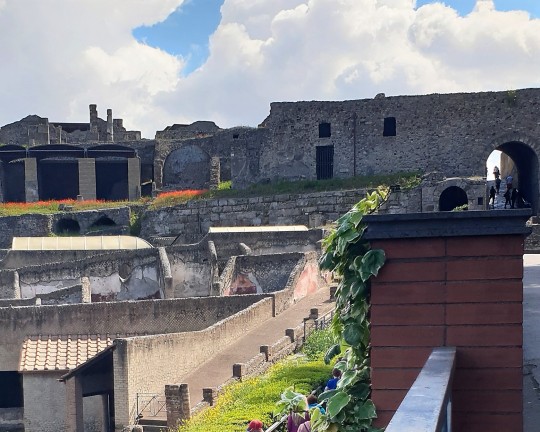
First view of Pompei, Porta Marina on the right
The first stop was up the path to the left, initially wanting to see the baths at the start but they were closed. It would be interesting to know the damage that was done during the 62 A.D. earthquake as most of the damage repair was still underway some seventeen years after. Vesuvius didn't do as much damage as we thought. It was still total mess though. A lot must have been cleaned up over the centuries as there was not a lot of rubbish lying around. Just what was left standing.
Almost immediately, Tom and Beau headed off ahead as they were quicker and wanted to do their own thing. The rest of us stuck together, for a while anyway. After we entered and exited Porta Marina, we noticed that the ruins of the Casa di Romolo e Remo and their neighbours, Casa di Trittolemo were still there, as they had been for millennia, so we had a look from a few angles and listened to the audio. More of a story to tell with a bit of history. It put a perspective on what it was all about.

Ruins heading up Via Marina
At the top of the path, a gate to our right led us off of Via Marina into Regio VIII (The Sacred City is the Profane City), and into a mostly cleared but interesting area, the Temple of Venus, which was being dug up ever so slowly as we watched. This place was totally ruined during the earthquake of sixty two and was probably in the process of reconstruction when Vesuvius erupted. Further inconveniences were encountered when the site was bombed a couple of times during WW2. Only ruins and foundations remain as most of the stone was removed and redeployed on other projects over time. The statue in the centre was what was still left of an artistic exhibition a few years ago.
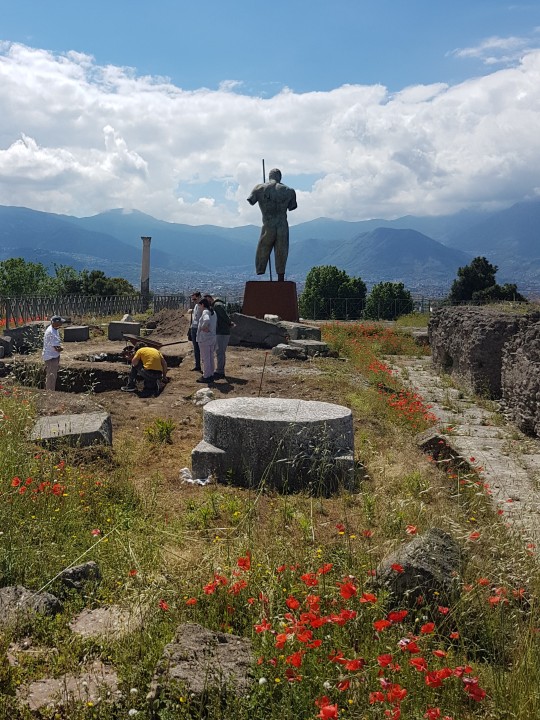
Temple of Venus (REGIO VIII - INSULA I). Statue by recently deceased Polish artist Igor Mitoraj from his 2016 Pompei exhibition amongst the Temple of Venus ruins. Archaeologists slowly toiling away. Excavated in 1852, 1869, 1872, 1898, 1937, 1952 and 1984.
Returning whence we came, Via Marina took us to the Forum and to the Basilica. This area was under scaffold last time we were there and fenced off. This time there was better luck to be had as there was freedom to roam around. Quite impressive. The elevated stage was where judges sat dealing out punishment for the locals. Apparently, it was for their own protection, it protected them from those who were not happy. Much work has been undertaken to reconstruct what must have been. The bits that fell to the ground (and not pilfered of reused) all those years ago must have been laying on the ground where they collapsed and put back up.
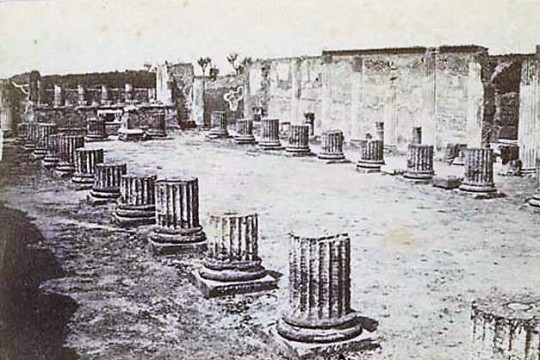
Pompei Basilica prior to 1875 (PompeiiinPictures)

Basilica remnants today (REGIO VIII - INSULA I). What's left of the most sumptuous building of the Forum, used for business and for the administration of justice. Dating back to between 130 to 120 B.C., the basilica represents one of the oldest examples of this type of building in the entire Roman world. Date of excavation: 1806; 1813; 1820; 1928; 1942; 1950
Following further group separation and heading toward an area that had not been seen before, rather than going over the same stuff, the southern side was the go. On our last trip three years ago, much of the area overlooking the Sarno Valley was fenced off for safety reasons. The area has since been refurbished, if that's the correct word and made accessible. Impressive villas of the wealthy and some great mosaics were scattered throughout Region VIII. Facing Vicolo della Regina and built right on the edge of the hill, the location had great views overlooking the Sarno Valley to a distant Sorrento. Not all were open but some were. It seemed that there was not enough staff to man every exhibit so they opened them to a programme. Some were shut, some were open, but they all seemed to be open at some stage during the day if not being refurbished. Vicolo di Championnet was wedged between the southern walls of the Basilica and houses of the once wealthy. The House of Championnet was one such house and evidently one of the most sumptuous homes in the city. No much remains but they're protecting what is. The ruins extend at least four levels sloping scenically towards the sea. Vicolo di Championnet extended from the Sanctuary of Venus through to the southern end of the Forum and the municipal buildings. To turn right into the much wider Via delle Scuole and the inaccessible House of the Geometric Mosaics led to Vicolo della Regina and the similarly inaccessible gymnasium, Palestra dei Luvenes.

Scale model of Campania Regio VIII. House of Championnet to the bottom left, House of the Geometric Mosaics directly under the white label and Palestra dei Luvenes around the corner toward the top

The locked entrance to Palestra dei Luvenes (REGIO VIII - INSULA II). The gymnasium is located on Vicolo della Regina with an impressive floor mosaic in the entrance hallway, which depicts a fighting scene with two bare fisted athletes facing each other. The frescos on the walls portray athletes, wrestlers, a jumper with dumb bells, and the competition judge, known as the Ludi Magister, carrying a sash for the winner. Excavation date: 1887, 1928
Sticking to the southern fringes, Vicolo della Regina took a slight dog leg at the end of Vicolo dei Dodici Dei and continued down to the Triangular Forum and Samnite Palaestra to the left and the Sanctuary of Athena and Hercules and Doric Temples to the right. Beyond both were the two amphitheatres, imaginatively called the large one and the small one (Odeon). The Romans called the Odeon, the theatrum tectum and dedicated it to the most popular theatrical genre at the time, miming. Musical performances and singing were also popular. The large theatre put on comedies and tragedies of Greek-Roman tradition. It was also first of the large public building where the volcanic ash from the eruption was completely removed. It was probably never totally covered so an obvious starting point for excavators.
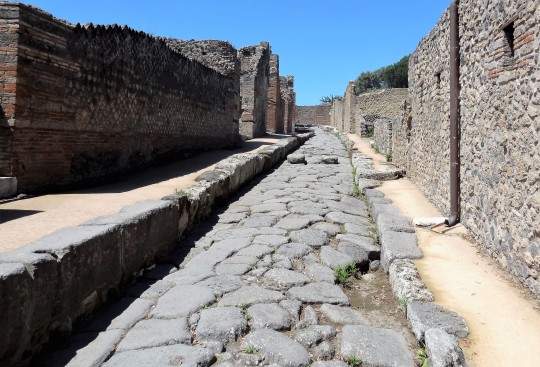
Vicolo della Regina
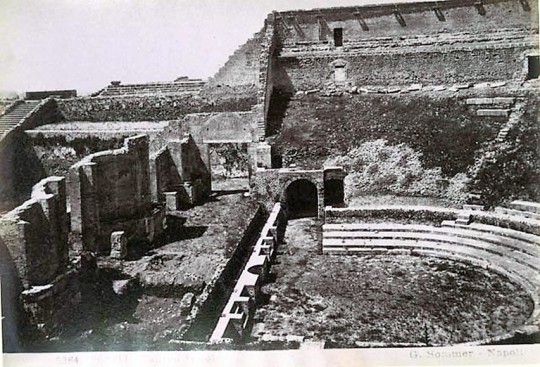
Teatro Grande pre 1870 (PompeiiinPictures)
Teatro Piccolo marked the eastern most point of Regio VIII. On the opposite side of Via Stabiana, Regio I (The City Commercial) commenced. Continuing on with the "wandering" through the alleyways, the next place to drop in on was House of the Ephebe, so named after a bronze statuette of Ephebus was found inside. Evidently, a wine merchant named Publius Cornelius Tages was the owner of the place.
Just around the corner and across from some seriously scaffolded buildings was a Thermopolium or small takeaway joint and further on, almost at the vineyards and the eastern limits of Pompei was the House of Venus in the Shell, fronting Via dell'Abbondanza but also on a side street, Vicolo della Venere. By crossing Via di Nocera, Regio I was left behind and Regio II (The City into the Green) was ahead.

The House and Thermopolium of Vetutius Placidus (REGIO I - INSULA VIII). This dude owned a property on the corner of Via dell’Abbondanza and a side lane unnamed, and sold drinks and hot food, stored in large jars and placed in the highly decorated stone counter. The well maintained news stand at the rear held a lararium to the protectors of the household, Mercury (god of trade), Dionysus (god of wine) and Genius (protector of the owner). Three kilos of silver coins (about 585 sesterces) were found in one of the jars, maybe hidden by the owner until the eruption calmed down. 89 thermopolia have been excavated so far. Date of excavation: 1912; 1939

The garden of the House of Venus in the Shell on Via dell'Abbondanza (REGIO II - INSULA III). The beautiful garden in the centre of this villa is the focal point around which the house was built, perystylium surrounding the garden. The back wall of the peristylium is decorated with a spectacular fresco with Venus, which gives the house its name. On the lower part, a luxurious garden is depicted over a barrier with exotic plants and animals. The upper part of the wall is divided into three panels with different scenes, to the right, a fountain that birds drink from and to the left, a statue of Mars with a spear and shield on a pedestal. In the centre, two cherubs accompany Venus, protectress of Pompei and the erotic sphere, lying in a large shell. The house belonged to a branch of the family of the Satrii, very prominent in the last few years of the city. Date of excavation: 1933-1935; 1951-1953

Mars and Venus in the Shell
Keeping half an eye on the time, which wasn't easy since Shane didn't have a watch, the next area was across town rather than straight back toward the Forum. There was still well over an hour to go but with half of the ruins yet to see. Via dell'Abbondanza was chockers with people, many of them kids in school groups ranging from small, up to teenagers. They overwhelmed everything that they went near, making the place claustrophobic. This made the change of direction an easy choice, back to Via Stabiana and in turn Via dei Vesuvio, taking notice of the renovation work at the Terme Centrali, the central baths that were the largest in Pompei, covering an entire block of the ninth insulae and still under construction when Vesuvius erupted.
A block further on and across the street was the House of the Golden Cupids. Well worth a look. From there it was through the non existent Porta Vesuvio and onto a small mausoleum outside of the city walls. Necropoli di Porta Vesuvio held four tombs, most notably that of magistrate Caius Vestorius Priscus, dated to 75-76 AD. A small rise adjacent afforded elevated views across Pompei allowing for a look back at progress that had been made thus far and an appreciation of the city layout from the northern edge. Excavated Pompei to the right and paddocks to the left.

Excavated to the right (REGIO V, INSULA I), unexcavated to the left

Terme Centrali (REGIO IX, INSULA IV). The eruption preserved the baths in an incomplete state but the ambition and intention of the architect is apparent from the façade overlooking the courtyard. The bathing rooms are more spacious and brighter than anything else around. Date of excavation: 1817; 1836; 1877-1878

House of the Golden Cupids (REGIO VI - INSULA XVI). Located on Via dei Vesuvio, this house represents one of the most elegant of the Imperial era. The building is set around the spectacular peristylium with an equally spectacular garden. Named after the Cupids engraved on two gold medallions that decorate a cubicle of the portico, graffiti and a seal ring indicate the owner as Gnaeus Poppaeus Habitus, a relative of Poppea Sabina, Nero's second wife. Date of excavation: 1903-1905
Time must have been getting on. Without a watch, Shane had been prying over peoples' shoulders to keep an eye on the time. Someone's watch said one o'clock so it was off to the brothel, right back in Vicolo del Lupanare, Regio VII, Insula XII. Vicolo dei Vetti was the street chosen for the return trip, starting off at Porta Vesuvio and running next to, but not parallel to Via dei Vesuvio. As luck would have it, directly behind the House of the Golden Cupids was another interesting one, the House of Vettii. Mistaken initially for possibly a brothel due to the paintings and statues with big dicks adorning the place, it ended up being the home of a couple of rich bastards, maybe full of their own self importance.
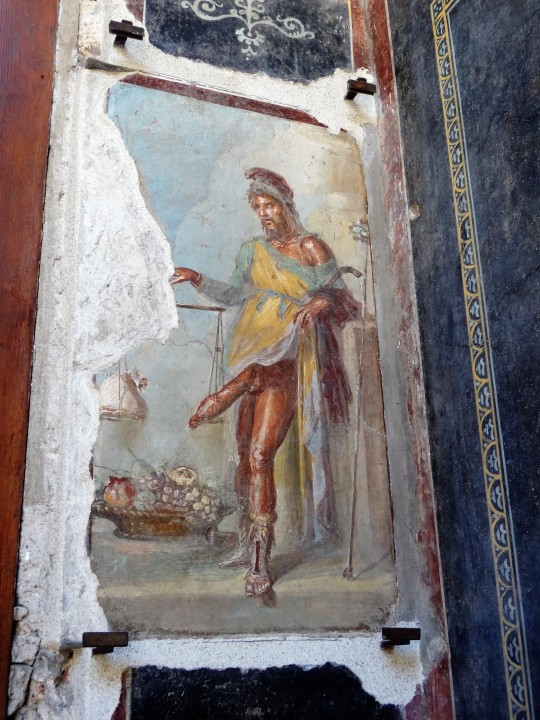
What's the heaviest? Priapus' bag of coins or his hanging member. Good health is worth its weight in gold. The House of the Vettii (REGIO VI - INSULA XV), belonged to the brothers Aulus Vettius Restitutus and Aulus Vettius Conviva libert, wealthy traders whom had the god of prosperity, Priapus, painted to the right of the door within the vestibule. Graffiti at the entrance of the house indicates that the prostitute, Eutychus, who was a slave offering herself for two Asses, carried out her affairs in the adjacent room, decorated with a number of erotic paintings. Date of excavation: 1894-1895.
Time was certainly getting on and the brothel was getting no closer. The dead end at the end of the street forced a left turn into Via della Fortuna and next right into Vicolo Storto. A further barrier at Via degli Augustali forced a right turn. No planning went into the trip and it was showing. On the right path, the next turn should have been Vicolo del Lupinare, the brothel street and it was however there were temporary barriers in place again forcing a detour. And what a detour it was, with Vicolo di Eumachia blocked off, the next street was right back to and across the Forum, and then back down Via dell’Abbondanza. It added heaps of time on to the journey. What one will go to visit a brothel. Anyhow, we had the kids last time and didn't know what to expect so weren't too disappointed when we missed out. Not this time though. Not knowing that lupanare was brothel made the building identification more difficult than it should have been but it worked out in the end. Interesting but quite bland. A few small, bawdy frescos on the walls and a half dozen tiny rooms with stone beds. The building was quite small so there was a small queue trying to get in. Once in, it only took a few minutes to look and then it was off back to Jo and Cec around the kiosk. It was time to head off.
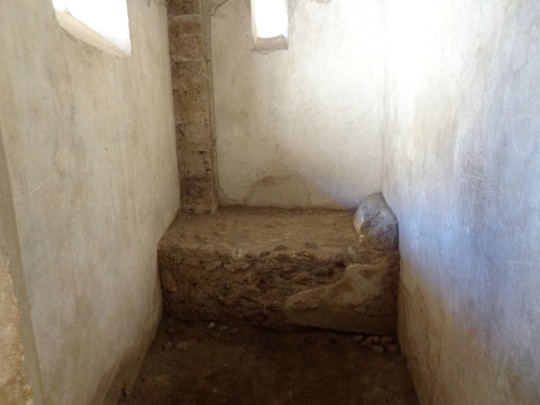
Bed in the Lupanare (REGIO VII - INSULA XII). For those who like it firm. The five bottom floor rooms with built in beds were located on both sides of the corridor that connected the two entrances to the knocking shop on the corner of Vicolo del Lupanare and Vicolo del Balcone Pensile. The prostitutes were largely Greek and Orientals who earned between two and eight asses per root. (One ass bought a glass of wine). They and the brothel owner lived upstairs. Date of excavation: 1862
The reunion went pretty well. We all turned up in the right place, except for the boys, and the right time. Regrouping, we headed back to the front gates, past the Temple of Giove, back through the Forum and out the front gates, handing in our handsets as were exited.
Upon leaving Jo phoned Tom and Beau and found they were in a bar at the other end of the site. They left straight away and ended up meeting at the train station. They told us that afterward that they were finished and looked for pizza down the bottom end of Pompei with the restaurant spruikers shouting across the road for business. In the end the one they chose walked to the middle of the road and stopped traffic in both directions so that they could buy their food off of him. It ended up a pretty ordinary pizza anyway.

Granai del Foro (REGIO VII - INSULA VII). The granary stretched along the western side of the Forum with eight openings separated by brick pillars and were used as for the fruit and vegetable market (Forum Holitorium). These days some nine thousand artefacts, the most important archaeological pile of terracotta crockery that was used in the last decades of life of the city for the everyday activities are stored there. Date of excavation: 1816-1822
The timing for a train was a guess, we must have just missed one as it was probably a half an hour before one turned up and when it did, it whirred along the tracks, the electric motors propelling us along as if they were about to explode. They didn't and within twenty minutes we were getting off at Ercolano Scavi and walking down Via IV Novembre to the entrance to Herculaneum, the next ancient site that was destroyed by Vesuvius we were visiting for the day.

Entry to Herculaneum
As was the case with Pompei, Herculaneum was forced to survive under the sphere of Nocera until the Social War and the domination and municipalisation process that Rome imparted on all of central and southern Italy. The city was much closer to Vesuvius, also built on a volcanic plateau but also on a sheer cliff above the Bay of Naples. As with Pompei, the city underwent a construction renaissance during the Augustan period with many public buildings being built or done up. The earthquake of 62 A.D. shook the foundations of the city requiring repairs under Vespasian. The city is overall in much better condition than Pompei, mainly due to the pyroclastic flows that buried the place under an average of sixteen metres of volcanic rock that solidified, thus preserving the city in its original state and allowing organic artefacts as in plants, fabrics, furniture and timber boat parts to survive. The upper floors of some buildings also survived providing information of building size and construction techniques.

It is estimated that ancient Herculaneum covers an area of approximately twenty hectares, less than a third the size of Pompei however, only four and a half hectares have been excavated. Much of ancient Herculaneum lies beneath modern Herculaneum.

By the time we entered the site and walked halfway down the hill to the ticket sellers, Cec had had enough. Looking at the amount of walking ahead and the stairs and ramps involved in getting to the streets of the ruins, she decided to stay near the top and rest. We, on the other hand had an hour and a half to look around the best we could. We headed down to street level and again separated, only this time Jo and Shane stuck together.
House of Relief of Telephus. Apparently, along with House of the Gem next door, this joint belonged to M. Nonius Balbus and was the second largest in Herculaneum. Named after a relief depicting the myth of Telephus, son of the mythical founder of the city, Hercules, the house of three levels afforded scenic views down toward the marina. The house dates from the Augustan period and was remodelled after the earthquake of 62 A.D

School kids getting a lesson in one of the bath houses. The public baths were a big part of the Herculaneum lifestyle.

The Barrel Arches are vaulted rooms that provided the port warehouses and boat storage as well as supporting the terrace above. The rooms opened onto the beach and must have seemed a safe place for the three hundred odd souls that perished, many still lying in situ today. They apparently met their demise due to high temperatures created by the pyroclastic clouds reigning from above

The long ramp back to the top

The western sector of the South Terrace is a Sacred Area of varying rooms and two temples side by side, dedicated to Venus and four divinities
By four thirty we had had enough. Scaling the long path back to the entrance, picking up Cec and heading up to the station was laboured as we were all stuffed. Unlike Pompei, the train arrived as we hit the platform. We picked up all the time we lost at Pompei and more. The trip back to Naples was again cosy to say the least. So cosy in fact that Jo had an admirer in such close proximity that he was rubbing his so called manhood up against her. Her frotteur was certainly overly friendly. When she moved away he worked his way back next to her. It only stopped when she put her walking stick between them. It must have been her lucky day.
Arriving back at Garibaldi Station with plenty of time to spare allowed us to head straight for some tucker. We ended up near MacDonald's but found a place selling coffee, beer and pizza. We chose the pizza but afterward wished, regrettably, that we chose Maccas. The coffee was real good with a couple of sweets that we didn't recognise. Shane went back for another coffee but a different barista made it and was nowhere near as good. The food was crap.

Chip pizza for dinner. Yum

Vesuvius from Freccia Rossa
It was late when we arrived back at the apartment so we had a quiet one, a few downstairs and a genuine goodbye to the people that had made our time at La Biga so special.
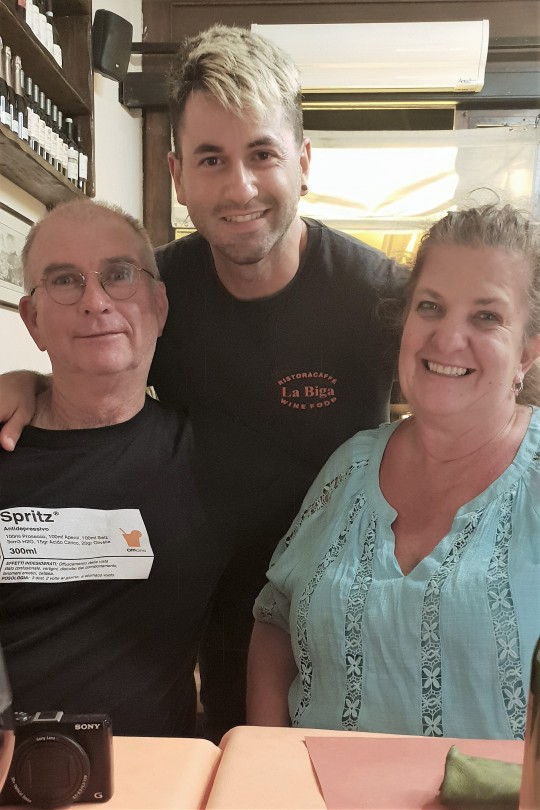
Last night at La Biga with Giuseppe
Packing was a priority before bed as we were to be picked up by our driver at ten to head to Fiumicino Airport for the long trip home.
0 notes
Text
Appia Antica & Saint Cecilia’s Basilica
16/05/2018: Today Shane and the boys intended to walk down Via Apia Antica or if possible, hiring a bike, the better option. The road was built during 312 B.C. and is lined with mausoleums and tombs of ancient Rome's dead as they were not permitted to be buried within the walls of the city. The Appia Antica was Rome's first gateway to the east connecting Rome with Capua, and eventually to Brindisi on Italy's south eastern coast where Roman ships would set sail for Egypt and Greece. During this time Jo and Cecilia planned to revisit the Trastevere district and visit Saint Cecilia's Basilica. The boys left a bit after eight, headed past the Coliseum to Circus Maximus, turned left into Viale delle Terme di Caracalla, and past the ruins of the Baths of Caracalla. The road from the chariot fields was three wide lanes wide and quite busy. As much as the central road was busy and clear of traffic, the two outside roads provided safer access and local traffic only, both lined with cars parked with a little more consideration than in the middle of the city.
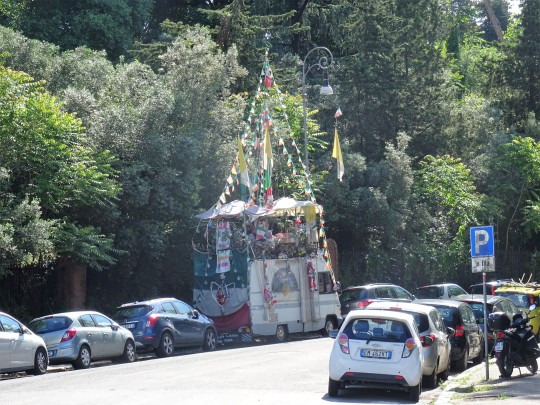
Hippies
At the end of Viale delle Terme di Caracalla, the road hit a major intersection, but they kept on straight ahead, keeping to the right hand side of a fork in the road. They ended up along Via di Porta San Sebastiano, had they have veered to the left they would have been in Via di Porta Latina, two ancient roads that bound Parco degli Scipioni, a park created by the joining of the first century AD columbarium of Pomponius Hylas and the tomb of the famous Scipioni family. The tomb was constructed around 280 B.C. by Lucius Cornelius Scipio Barbatus, great grandfather of Scipio Africanus, the great general who defeated Hannibal and his elephants at the Battle of Zama eighty years later.
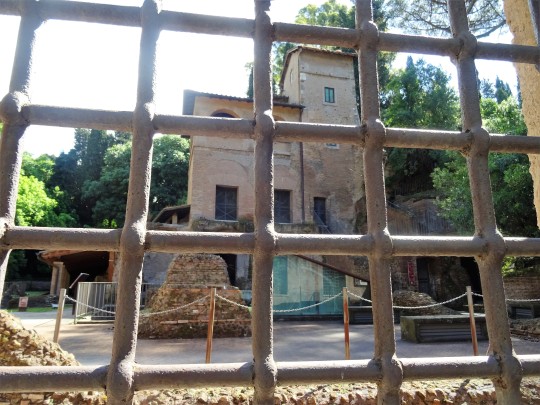
Sepolcro delgi Scipioni
A few hundred metres further on we finally passed through the Arch of Drusus and Porta San Sebastiano. We were effectively outside of the walls of Rome.
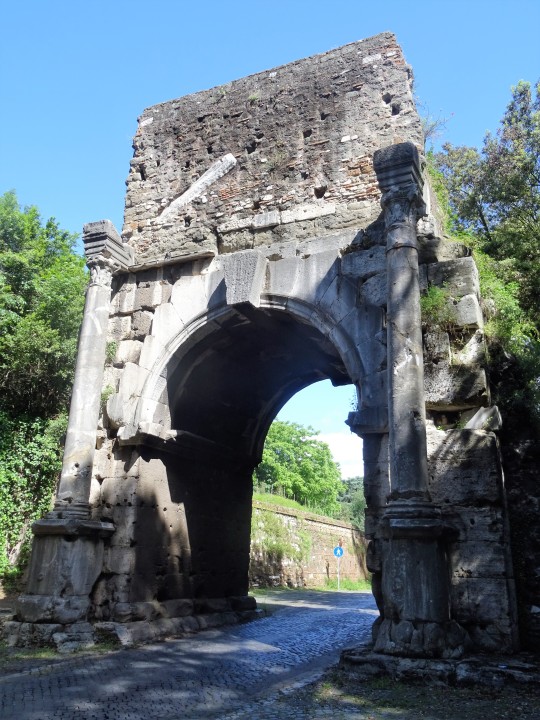
The so-called Arch of Drusus was an ancient arch that was utilised when Caracalla built the Aqua Antoniniana to supply water to his baths.
After passing through the gates they encountered a very busy cross road and from this point on, Via Appia Antica was also very busy. Walking along the side of the road, there was occasionally no room for pedestrians and also a bit hairy, but as the road got further along it widened out to where they could avoid the traffic, eventually reaching the bike shop that Shane and Isaac hired a couple of bikes from a few years earlier. Nothing had changed so they headed in and hired three bikes and a lock so they could look around as well.
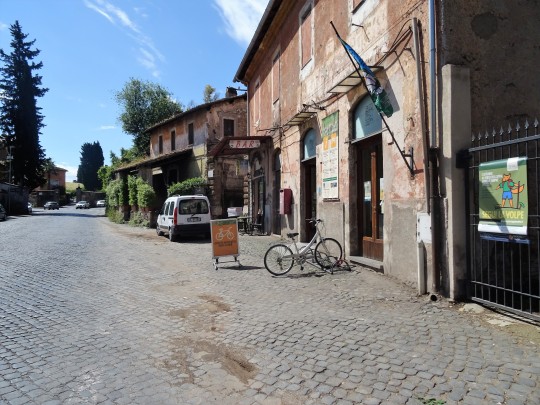
Affitto Biciclette Rent-a-Bike on Appia Antica
With a licence holding the security on the bikes and five euro each per hour, the lady behind the counter handed over a good map of the road with recommended sites, advising that access to the catacombs of San Callisto and entire area were closed as it was Wednesday. Not only had they missed out on the catacombs but if they could battle the hill at the entrance, it was a safe passage avoiding more of the hairy parts of the main road. The gates were locked so they rode along the hairy part.
While the boys did their thing with the bikes, the girls made plans to go back to the Travestere district to check out Saint Cecilia Basilica. As Cec's back was still playing up from the fall at Trevi Fountain, they planned to take a taxi rather than attempt the three and a half kilometre walk. Upon finding a taxi at the rank across from the apartment, the driver told them it would cost them fifteen euro. Cecilia's response was priceless. "What! To drive us three kilometres! You've got to be kidding mate!" She then said "Come on Joey, we will walk and find someone else. We're not getting ripped off by this bastard." Jo wondered if the taxi driver knew he just copped an Aussie spray.
After entering their destination for walking into the phone, Google Maps had them walking toward the Basilica. By the time that they found more taxis, there was still two kilometres to go. They kept walking though as those taxi drivers still wanted fifteen euro for the remaining distance. Their walk took them past the Forum, hooked a left around Altare della Patria (colloquially known as the Wedding Cake) and the small unobtrusive ruins of Comune di Roma alongside and eventually across the Tiber again.

One of the few remaining examples of how most Romans used to live. This Capitoline insula dates to around the year 110. Effectively a block of flats. Shops (tabernae) were on the ground floor with a few floors of apartments above. The shops are now nine metres below street level. Unlike these days the cheapest rents were the top floors as when a fire broke out, the top floor tenants were the ones more than likely getting burnt.
Just after passing the catacombs of San Callista on Apia Antica, the boys struck the catacombs of San Sebastiano with not many people around, so they headed in and asked about tickets. The English tour started in fifteen minutes for eleven euro each so after paying up they waited, taking interest in the displays in the foyer and the inside of the basilica.
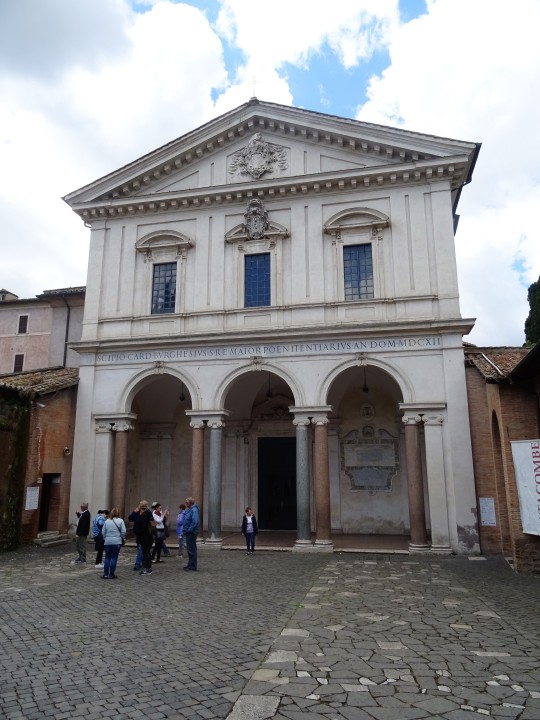
Basilica di San Sebastiano
Located between the second and third mile of the Appian Way, the current basilica was built during the seventeenth century on top of whatever was left of Emperor Constantine's Basilica Apostolorum built some thirteen centuries earlier. Basilica Apostolorum was built in honour of apostles Peter and Paul. Below Constantine's Basilica was ad catacumbas, the Christian catacombs that utilised the pozzolana quarry that the Romans had dug for their concrete. The three levels of catacombs held thousands of tombs ranging from the simple burial niche, and there were plenty of those, to Arcosoli and Cubicoli. The bodies were interred in the niches, wrapped in a shroud and covered with quicklime in order to promote the decomposition process and disinfect the tomb. The niche was then sealed.
When it was the boys turn, an American or Canadian guide escorted them to the inside of the Basilica an told of the history of the church and the story of Saint Sebastian. No tall stories here. No sticking his head under his arm and going home like Saint Miniato.
The guide also warned before heading into the catacombs that they were quite welcome to take photographs everywhere except in the catacombs. He explained that the church had no issues with taking pictures but the Vatican owned the catacombs and taking photos was strictly forbidden. Only one thing to do, hang around the back of the group. They were taken beneath the basilica via a steep set of steps within the foyer area and were immediately negotiating narrow cavities with side passages that were full of small empty tombs. Apparently, according to our guide, Romans were rather small people.
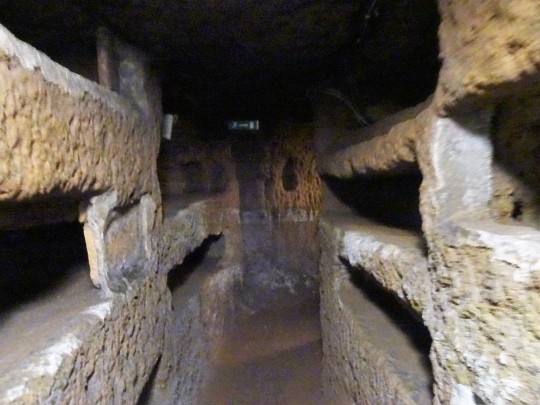
Underground tombs all empty
They kept moving through the narrow corridors, all along behind the group and snapping away. As they reached the underground burial area of San Sebastiano himself, they had another guide right up their clacker escorting a private German group, with the agility of Erwin Rommel. "No photos" came the continual yell as people around them had the same idea. Timed correctly, they still managed get a few more, but not of the excellent family ones which were directly below the basilica floor. The brick piers of the floor were founded on the rock that the crypts were carved into.
Originally a Roman soldier during the late third century, San Sebastiano got himself into some hot water with Emperor Diocletian for persistently converting the pagans to Christians. Now Diocletian, stabiliser of Rome and Christian persecutor, thought he would sort Sebastiano out by making him target practice for his archers, ordering him to be tied to a stake or tree, depending on which painting you believe and filling him with arrows to the point where he apparently resembled a sea urchin. The archers, thinking he was dead, left the scene allowing Irene of Rome to drag him away and nurse him back to health so Diocletian could have another go. This time San Sebastiano was beaten to death and thrown into the sewers, only to be removed and buried in the catacombs below Rome. The double martyr and gay icon was eventually reburied beneath the Basilica.
One of the characters that San Sebastiano converted, a woman named Zoe, had apparently been a mute for a few years and as soon as she converted to Christianity, her speech returned to her. A bit like Brian jumping on top of the hermit. The hermit hadn't said a word for eighteen years until Brian came along. A miracle.
After exiting the bowels of the basilica via a staircase back into the nave, the relationship between the memorial to San Sebastiano and his burial site became more apparent. They were directly above and below each other.
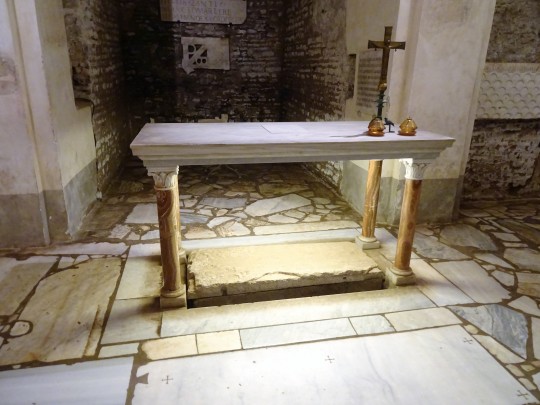
Tomb of San Sebastian below the Basilica
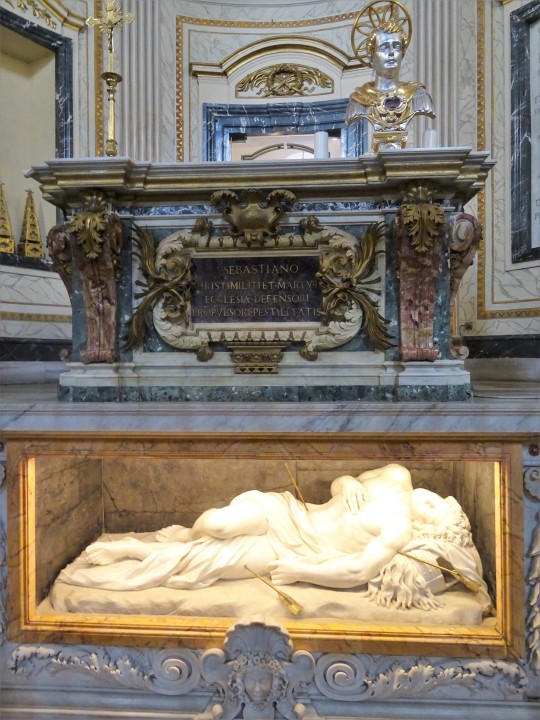
Memorial to San "I'm not dead yet" Sebastiano straight above. An arrow to the guts
The next stop was a quick one at the Mausoleum of Cecilia Metella, a large masonry structure with an imposing cylindrical tomb as its centre piece. Built between 30BC and 20BC, the mausoleum holds, or used to hold the remains of Cecilia Metella, the daughter of Roman Consul, Quintus Caecilius Metellus Creticus, and daughter-in-law of quaestor, Marcus Licinius Crassus who served under Julius Caesar. The family must have been well off for such a memorial. It only cost five Euro to get in but there wasn't much there. Still interesting though. The ticket seller told them that the ticket also allowed entry into a villa complex further down the road which was much more interesting.
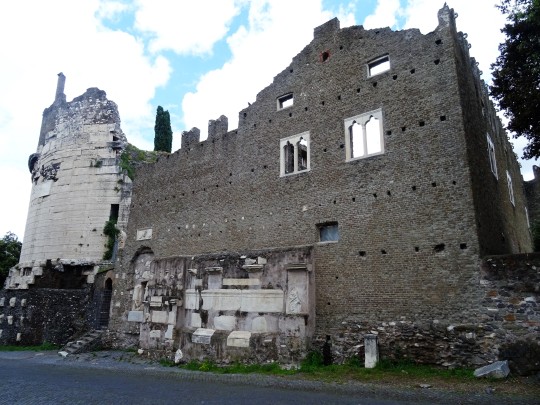
The Mausoleum of Cecilia Metella
CAECILI-AE
Q·CRETICI·F
METELLAE·CRASSI
After the ride up the hill to get to the mausoleum dad needed a rest, his muscles were jelly. History dictated that an oasis was just over the hill, at just over the three mile mark, so riding a short distance to the Appia Antica Caffe, they managed to put their feet up and have a feed and a beer (and a couple of Crème Broulee's for Thomas). Heading off after the rest, they took on the bumpy surface (at times very bumpy) of Via Appia Antica.
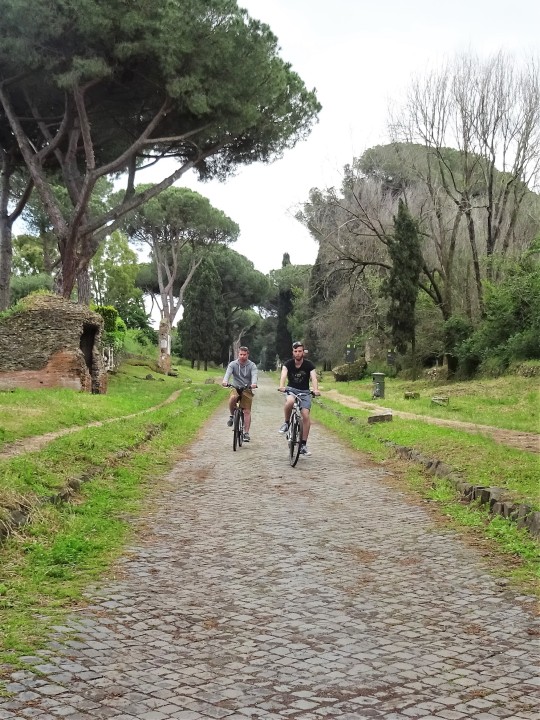
Via Appia Antica. A bit bumpy but this was the smooth bit
The next stop was beyond the fifth mile and prompted by a sign on the roadside and an interesting building behind the trees. An inkling of interest took everyone down a gravel lane and to the recently acquired Santa Maria Nova complex which once belonged to the Olivetan monks and the latest addition to the Parco Archeologico dell'Appia Antica albeit acquired over ten years ago and linked via Appia Antica to the Villa dei Quintili which fronted via Appia Nuova. The farmhouse was renovated during the eighteen hundreds and complimented the medieval watchtower. We couldn't get around the building again as the place was under another reno while we were there. Nearby excavated ruins included a bathhouse with very degraded but still impressive mosaic floors depicting a gladiator with net and trident doing who knows what since the rest was missing and a few circus horses. A walk through the paddocks then led to the Villa dei Quintili, an ancient Roman villa which included an extensive thermal system fed by its own aqueduct as well as a hippodrome from the fourth century.

Checking out the mosaics of the hot rooms near Santa Maria Nova
A long walk was then ahead as meandering from rock pile to ruin and ruin back to rock pile seemed to be the go. A quick look into the tanks or such halfway along what was once the northern portico and then onto the main complex. This was an extensive build, remnants still very high and expansive, easily accessed via well placed ramps and walkways. Signs and explanations of the workings of the joint alluded to the opulence that permeated through the place in its heyday.
The Villa was once a substantial complex, one that was one of the most lavish of the large Roman residences. Originally built by a couple of consuls of Greek origin, the complex was expanded upon once Emperor Commodus took over and made the villa imperial property. He liked the place so much that he had Sesto Quintilio Condiano and Sesto Quintilio Valerio Massimo murdered to make the deal possible. Villa dei Quintili consisted of main rooms, two large termes of the caldarium and the frigidarium. Large windows and marble everywhere. All overlooking the fields and Roman countryside.
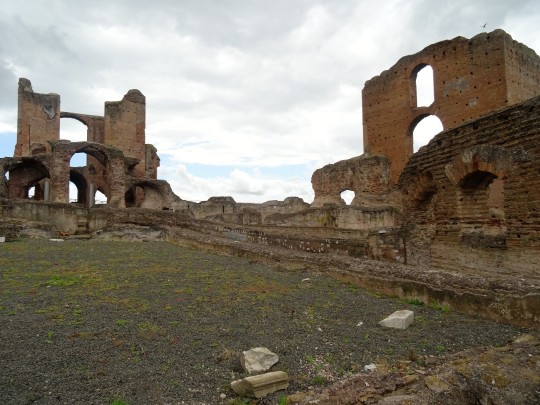
Looking across the once arcaded courtyard toward the frigidarium (cold baths) and tepidarium (warm baths)
It was time to return as the walk back would take time. All roads not only led to Rome but in this instance back past Appia Antica Caffe for more well deserved refreshments. A second beer pulled everyone up and it was then decided to take the apparent safe way back, down Via di Cecilia Matella and through to the nearby country road which, by the way, was never found. There was so much traffic on Via Appia Pignatella that it was difficult to cross and quite dangerous. The road was narrow with plenty of cars, but it was the wrong road as access to the bush was back at the intersection where another couple on bikes were stopped and looking around. Riding past them, up and over the mound that obscured the correct route would have turned into a dirt track, passing more ruins, cisterns and mausoleums as well as plenty of sheep and onto Via della Caffarella for a safe if not inclined journey back. But there was no turning back and the busy Via Appia Pignatella was the quickest way back. Some prayers and hope that the passing traffic, many sounding their horns, would manage to keep a safe distance when passing. After a nervy ten to fifteen minute ride, Via Appia Antica reappeared and a few minutes later the bike shop also reappeared. After a chat to the lady and obtaining more handy advice, a few Euro for bike hire was handed over a ticket on the 118 back to the Coliseum was purchased. The bus stop was located just across from the shop and after twenty minutes the bus appeared. The walk back to the apartment was keenly avoided.
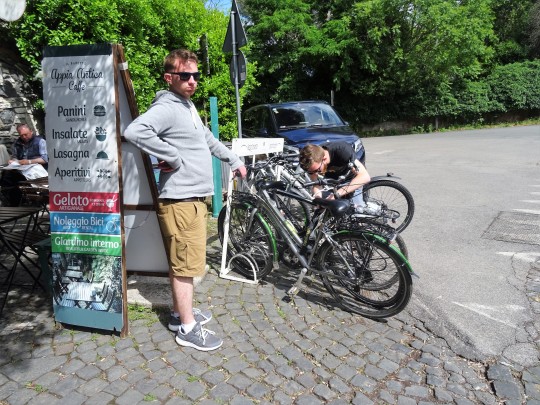
Locking up again for a beer
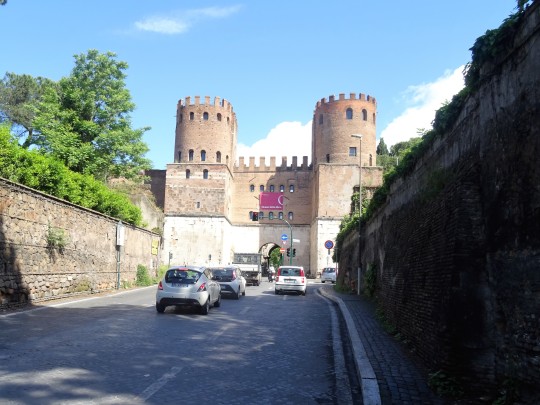
Heading back towards Porta San Sebastiano and the Aurelian Walls
Back at, and not long after arriving in Trasevere, Jo and Cec found a nice little restaurant, Trattoria Da Teo, that was full of locals and wine only came by the litre. Pizza for Cec and gnocchi for Jo. After lunch they wandered on to Saint Cecilia Basilica but it was closed. They took plenty of photos and checked out the local area before cabbing it back to the apartment.
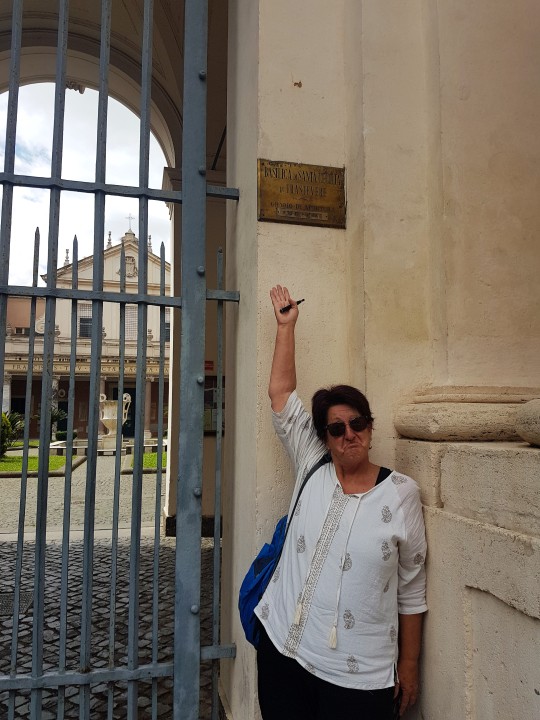
Cec at Cecilias
After a brief recovery period we all retreated to the restaurant downstairs for a meal, a few refreshments and more recovery.
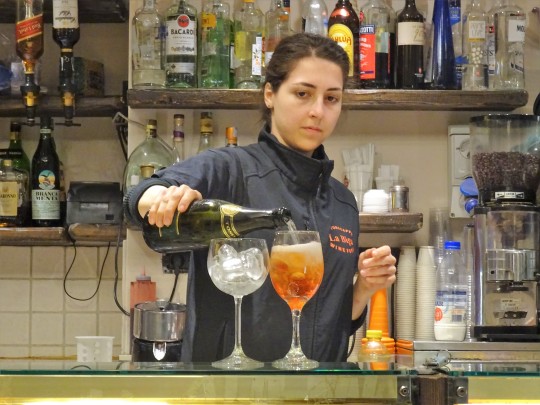
Homa making us a few drinks
Tomorrow Pompei and Herculaneum.
1 note
·
View note
Text
Coliseum and Forum Romanum
15/05/2018: Today we separated into two groups as Jo and Shane, as much as it is sensational, have seen the Coliseum so Cecilia, Tom and Beau, yet to do so, headed to their meeting place about ten thirty. We tried to book a couple of skip the line tickets with Get your Guide for the Forum. As it turned out we had to book for all three sites, Coliseum, Forum and Palatine Hill, which we did. The best we could do was eleven thirty five, two hours away, so we hung around a bit before heading to our meeting place at the western end where everybody seemed to be. After a few questions, we were queuing up at the entrance with all the other supposed skip the line people. We think it was a bit of a scam as no line could be found, particularly after the security scanner which seemed to be trying to find people keen on ruining ruins.
It was anything but a pleasant day today. Overcast skies greeted us as we approached the Coliseum forecourt and deteriorated to light rain as we queued. A bit of mucking around was the first thing with us trying to synchronise Rick Steve's audio with one set of earplugs as we wandered towards the Arch of Titus, the triumphal arch erected by Emperor Domitian in 81. The arch commemorates the victories of his father Vespasian and his brother Titus in the Jewish War in Judea some ten years earlier. The two laid siege to Jerusalem for a couple of years, starving and eventually slaughtering its occupants and raiding the vast riches of the temple. They finished off with burning the city down and destroying all but one of its walls, a statement that no walls could defend against the armies of Rome. The Wailing Wall is all that remains today. Thousands of Jewish slaves were brought back to Rome and were put to work building the arch and the Flavian Amphitheatre.
The last time we were there we could sit beneath the arch but it was now fenced off. It was continually full of school kids sitting down and being lectured to by their teachers, but not anymore.

SENATUS POPOLUS QUE ROMANUS DIVO TITO DIVI VESPASIANI F VISPASIANO AUGUSTO (The Senate and People of Rome, to Divus Titus, son of Divus Vespasian, Vespasian Augustus)
Fifty metres down Via Sacra and a right turn along a small tree lined path had us looking up at an enormous arched building of which less than half remains. It was at this time that the skies opened and we were looking for shelter. The Basilica of Maxentius was fenced off so we couldn't head there. Some of the ruined arches were thick and dry beneath but were immediately filled with people closer than us. We headed back along the path where we stood under some of the trees at the garden edge. This with our expensive jackets and cheap umbrellas gave us some protection.

Basilica of Maxentius (or Constantine). One started it and the other one finished

Looking up at the Farnese Gardens and Aviaries on the Palatine Hill from under the trees
There rain did not let up for some time so we put up with it and headed back down Via Sacra towards the Temple of Vesta, but not before checking out the Temples of Antoninus Pius and Faustina and that of Divus Romulus (or possibly Jupiter Stator). An easing in the weather allowed us to take stock and have a good look at the Vestal Virgins.

Jo and the Temple of Antoninus Pius and Faustina
The Temple of Vesta was associated with one of Rome's most ancient and important cults and as such possibly Rome's most sacred locations. It was within the circular temple that the Vestal Virgins tended the sacred fire that perpetually burned as a symbol of the city's life force. For as long as the flame burned, Rome would stand.
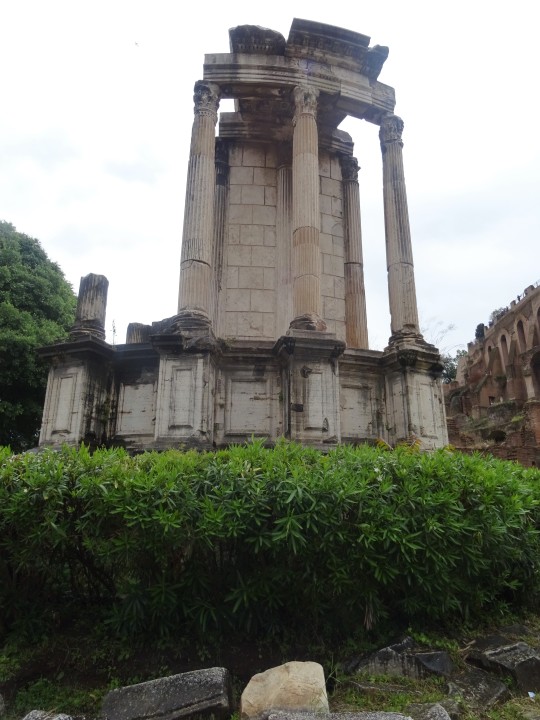
Temple of Vesta. The remains date back to the 191 restoration by Septimius Severus
Behind the temple was the courtyard of the House of the Vestal Virgins and the scant remains of what was once the building in which they lived. The six Vestals were chosen by the Emperor in his role as Pontifex Maximus from noble families and served a chaste existence for thirty years. They were aged between six and ten years old when chosen. Those who managed to last the distance were rewarded with large dowries and allowed to marry. Those who didn't were paraded around the town in a cart, given a loaf of bread a lamp and entombed in an underground chamber. According to the information we were given via our Rick Steves commentary, not many lasted the distance.
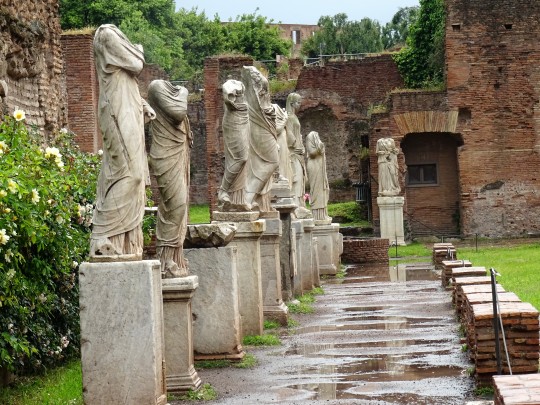
Remains of the Statues of the Vestal Virgins
It was then back down to Via Sacra and a left turn to the Temple of Julius Caesar who was assassinated in 44BC, stabbed 23 times by political conspirators. Not much of the temple remains but a metal roof covered the spot where Caesar was cremated. Shortly after his death Julius was deified posthumously by the Senate and his adopted son, Augustus, later to become Emperor Augustus begun the temple's construction. Fifteen years after his death Augustus dedicated the temple to him. A look behind a remaining wall at the front revealed the mound of dirt where he was supposed to have been slain. Flowers were strewn over the mound.

What's left of Temple of Divus Iulius
Being a little underwhelmed by the Caesar experience, although at least some of it survived, we wandered further down Via Sacra to the Forum Square, where it all happened. The square stretched to the foot of Capitoline Hill and was once surrounded by temples, law courts, government buildings, triumphal arches and such. Being the busiest and seediest part of town, the square was crowded with all sorts, from senators and politicians to pick pockets, gamblers and prostitutes. As is the norm with today's Romans, their ancestors also used the outdoor piazzas or squares to get some air and spend time with their friends and neighbours.
Veering off of the main street, we found ourselves looking across the almost vacant area that once contained Basilica Aemilia towards the Curia, where the Senate was housed. This was fenced off as was the Arch of Septimius Severus. By this time we could go no further. Stuck at the base of Capitoline Hill. Heading down towards one of the oldest roads around, Vicus Iugarius, we passed the columns of one of the oldest structures in the Forum, the Temple of Saturn. The original temple was built during 497BC and housed an old wooden statue of the god Saturn. More importantly, the statue's pedestal held the city's treasury (gold bars, coins and jewels). The present ruins are the third incarnation of the temple. It replaces the version destroyed by the fire of Carinus in 283 after being completely rebuilt in 42BC.

Arch of Septimius Severus, Roman emperor from 193 to 211

What's left of the third incarnation of the Temple of Saturn
That was just about it. We were on Vicus Iugarius, and looking toward Palatine Hill. Just to our left were two final but no less important structures. The Rostrum, a raised platform where Roman freedom was no more apparent. Rome's orators could stand on the three metre high platform, try to draw a crowd and sway public opinion. The other was the Column of Phocas, the last monument to be put in the Forum. The column was a gift from the Byzantine Empire in 608. It was presented to a Rome on the decline. A final nail in the coffin of a fallen empire, it commemorated the pagan Pantheon being given over to the Christian church. The thousand year rule of Rome had come to an end. The place was looted by Vandals and the population dwindled from one million down to ten thousand. The once grand centre of Rome was abandoned and subsequently buried under centuries of silt and dirt.

The Column of Phocas with the ruins of the Rostrum in the foreground

Looking across Basilica Julia to the Temple of Castor & Pollux. Arch of Titus behind
Our next step was to check out the Farnese Gardens on top of Palatine Hill. Halfway up the steps, we came across some sort of grotto with plenty of water leaking out of the rock. Probably some sort of miracle and supported by a light show on the bare surfaces. Then a storey above was the gardens and aviaries, created during the sixteenth century, when leading Roman families controlled the land on the Palatine. At this point the rain bucketed down so we paid more attention than usual to the place. Statued out, we left the aviaries and headed for the lookout above the old palace, looking over the entire Forum. The place was pretty packed but the rain got heavier as we approached the edge and the crowd split, looking for shelter. We had our five Euro umbrellas which kept us reasonably dry but continually threatened to turn inside out. We got away with it, had a good look with plenty of room and saved our umbrellas. The rain was only getting heavier so we made a beeline for the covered access to the other side of the Palatine Hill.
Ruin upon ruin, this place must have been remarkable in its day. The weather made everybody scamper so no effort was needed to wander around and through Domus Flavia and Domus Augustana to the Stadium and Severan Complex.

Stadio Palatino, or more specifically a gardened hippodromus where horses were exercised.
By now we had had enough and headed for the exit, satisfied that although there was more to see, we took our time and were happy with the experience. A down side was Jo's choice of footwear, having chosen shoes that ended up being so waterlogged that water squeezed through her toes and out the top as she walked.
The return trip was back along Via di San Gregorio, kept the Coliseum to our left and ended up following Via Celio Vibenna to a small restaurant where we could dry out, have a drink and a late lunch. After looking what Crab Ristorante had on offer, fish and crabs by chance, we entered the place next door where we had a simpler meal including a delicious serve of trippa (tripe). Osteria Angelino, although only a small shop front was quite large inside. There were a reasonable number of people inside with as many at the bar as eating. They must have been locals as they seemed to know each other.
Lunch finished, we headed back to the apartment via the local supermarket which was just a stone's throw way. Laden with supplies we walked back up Via Nicloa Salvi. On the way we witnessed hat we thought was a funny sight. There were four or five unmarked police cars rushing toward the city centre with sirens blaring and headlights flashing. The front seat passenger was leaning out the window with a red paddle waving at traffic about to obviously give way.
When we all met up we discovered that the others had their tour in two parts. The morning was the Coliseum and at two thirty were to meet again for the Forum. Cecilia had had enough after the Coliseum. Her back had been giving her hell since her slip and crash on the uneven marble stairs at Trevi Fountain.
Pasta for dinner, another trivia argument and bed.
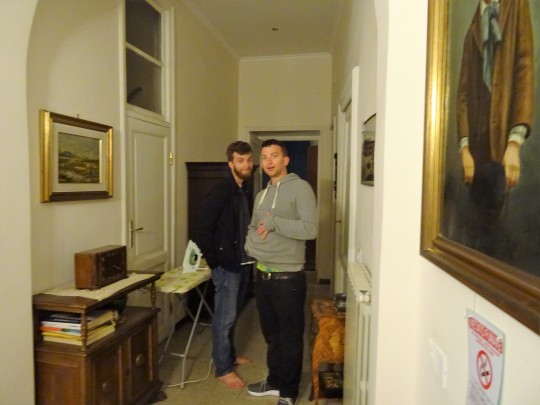
Time for bed
Tomorrow Apia Antica.
0 notes
Text
Vatican, Castel Sant'Angelo & Trastevere
14/05/2018: Today was a big day. Firstly, a trip to the Vatican to look around the Vatican Museums, something to fill in the middle of the day and then to the Trastevere for an evening food tour.
We made our way there by way of a couple of taxis, asking for Viale Vaticano and to be dropped off at Caffee Vaticano, straight across the road from the entrance to Musei Vaticani, the Vatican Museums. Waiting with the rest of the tourists on the steps at the end of via Tunisi and leading up to the Vatican from via Sebastiano Veniero, progress was made once everyone was identified and we were allocated our guide. As with the last time, although we did queue up in the Skip the Line line, we passed most of the people outside and went straight in, through the security and into the foyer of the museum.
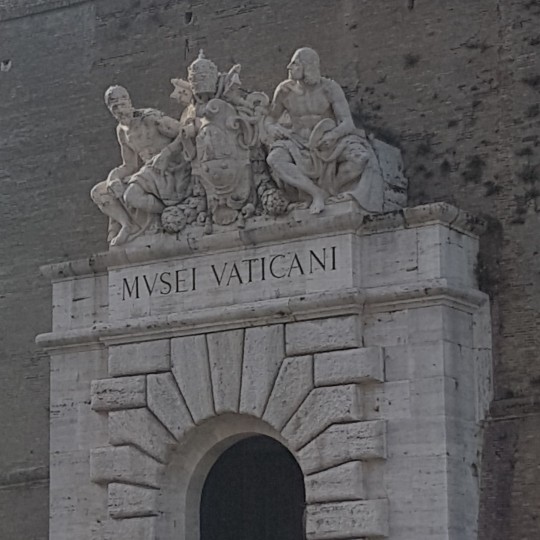
Vatican Museum entrance
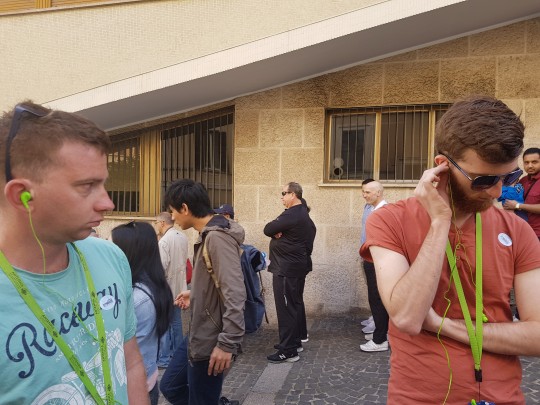
Making sure the ear plugs work
Unlike our last visit, this time our guide took us to the Cortile della Pinacoteca only to overlook the Giardino Quadrato rather than be part of it. Focus then quickly shifted to the Museo Pio-Clementino which was founded by a couple of popes from which it received its name, Pope Pius VI and Pope Clemente XIV. It held several galleries including Sala a Croce Greca and the porphyry Sarcophagi of Helena and Constantina.
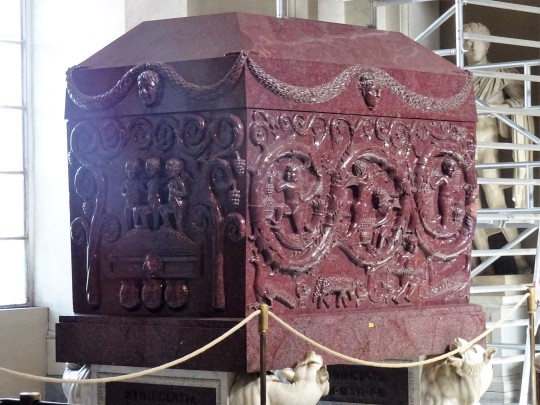
The red porphyry Sarcophagus of Costantia held the remains of the daughter of the Emperor Constantine the Great. A similar sarcophagus nearby once held the remains of her grandmother, Helena
Next stop was to check out the Flemish tapestries displayed within Galleria degli Arazzi. They were in pretty good nick, not sure if they were faded or not. One would think so if they were first displayed in the Sistine Capel during the first half of the fifteen hundreds.
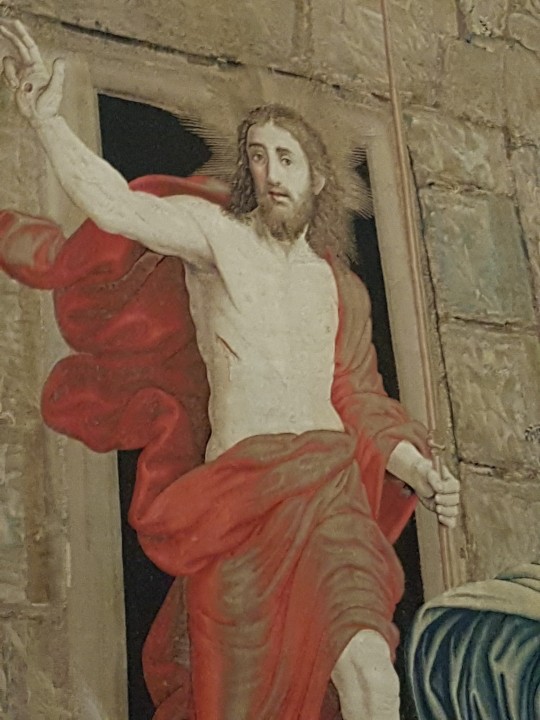
Taxi!!!
From the tapestries to the maps. With both being in hallways, the only complaint would be that no one could get back far enough to appreciate the works from a distance. The Galleria delle Carte Geografiche was as before, excellent. Possible one of the best displays in the whole joint.
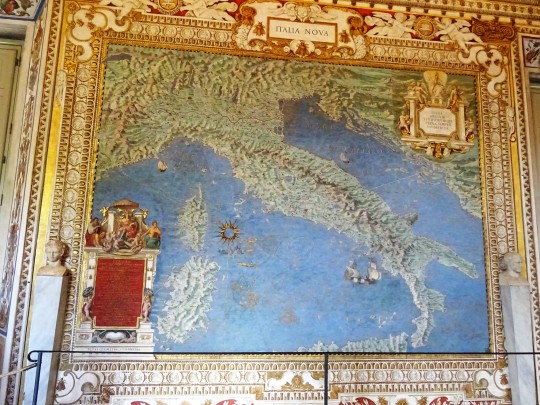
Old Italy, one of forty geographical maps painted on the walls depicting Italian regions and the possessions of the Church at the time of Pope Gregory XIII
By ten we were well into the museum thing and well into the Stanze di Raffaello including Sala Sobieski e dell'Immacolata and stanza dell incendio di borgo. We had to move on though. The Sistine lay ahead.
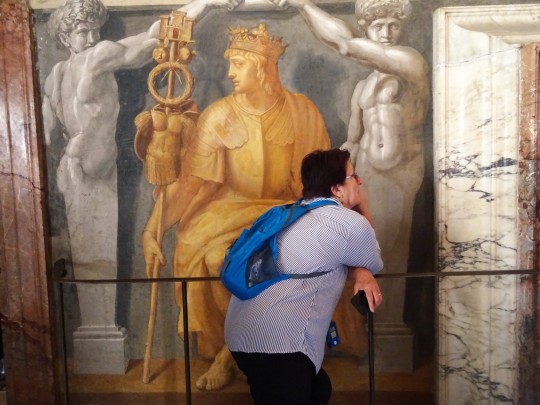
She was Raphael'd out
One more room to go, the Sistine Chapel. But no, there was one before that, a contemporary display of more recent artists. They were long since gone but not as long gone as most in there. The small rooms contained the likes of Rodin, Morlotti, Van Gogh and Salvador Dali amongst other Spanish displays.
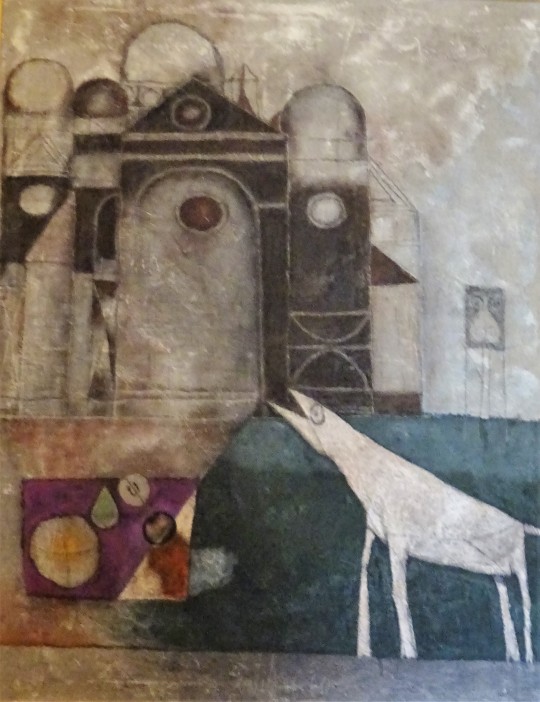
Franco Gentilini: Cattedrale con natura morta e cane
Unless one wants to clinically identify all the stories within the ceiling of the Sistine Chapel, it doesn't take too long to check out. As magnificent as what it was, ten minutes pulled the place up. We all walked into the room and were immediately under the watchful gaze of the Noise Nazis. There were people everywhere which made it doubly uncomfortable. Wandering around like Brown's cows, our necks cranked upward, it was not hard to appreciate the beauty of the artwork, the striking scenes and stories, the complicated layout and above all, the tremendous feat Michelangelo managed in laying on his back for so long to get it all done. The room morphed from silence to rowdiness and back to silence depending on the frequency of the "shooshes" from the Noise Nazis as well as the constant bellowing of "No Photos", "No Photos". Stuff 'em. Typical Vatican, only allowing photographs of what they say. We got a few good ones in though.
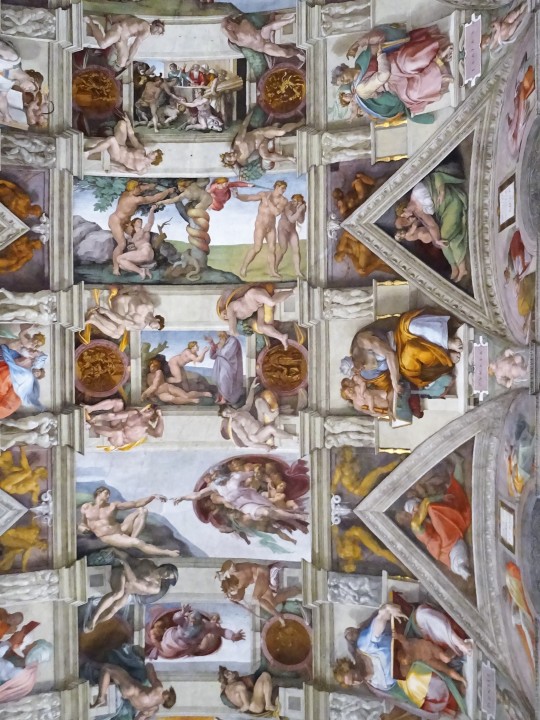
Sneaky one in the Sistine Chapel. Scenes from the bottom up, the Separation of Land and Water, Creation of Adam, Creation of Eve, the Fall of Man and the Sacrifice of Noah
A sea of admirers continually flowed in and subsequently out of the Sistine Chapel, mostly shoulder to shoulder for the duration of their visit. The few minutes spent inside were both congested and claustrophobic and as such, we joined in the outflow and rode the wave, past Scala Regio, down the ramp and into the courtyard, Cortile San Gregorio l'Illuminatore below. It was time for a short break. People could refill their water bottles with Holy Water from the fountain in the courtyard while the guide advised everyone of what was on offer around the area. Tickets to the top of the dome, the elevator if one was too lazy to climb the stairs and the gift shop. The next stage was to enter the Basilica so if anyone wanted to avail themselves of what was on offer in the courtyard they would have to return later. It was time to press on.
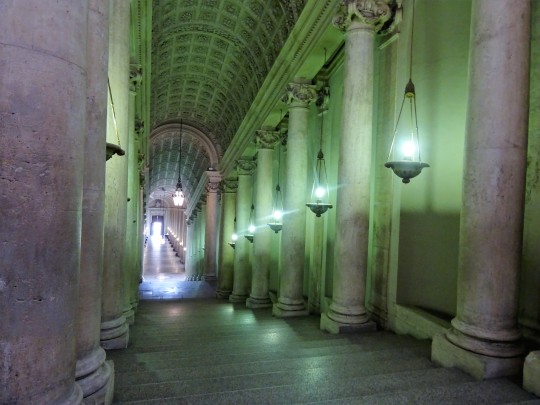
Looking down Scala Regia. The Bernini equestrian statue, Vision of Constantine was somewhere down there
Before long we were in the portico at the front of Saint Peter's Basilica and confronted by several doors which in at some point of time or for some reason allowed access to the Basilica. The first of five doors was the Holy Door, so named as it only opens during Holy Years which are twenty five years apart. Not only is it closed but bricked in so it cannot be opened inadvertently. The second was the Door of Sacraments, the one which allowed entry once through security. While queueing there was plenty of time to check out the oldest door from the early to mid fourteen hundreds. The Filarete Door was in the centre, showing six panels of religious stuff like Saint Paul losing his head and such, next to it was the Door of Good and Evil with each doors' panels showing as much and to the extreme left, the Door of Death which was the exit for funeral processions and the door where we would later leave the Basilica. Yes, we would be leaving via Death's Door.
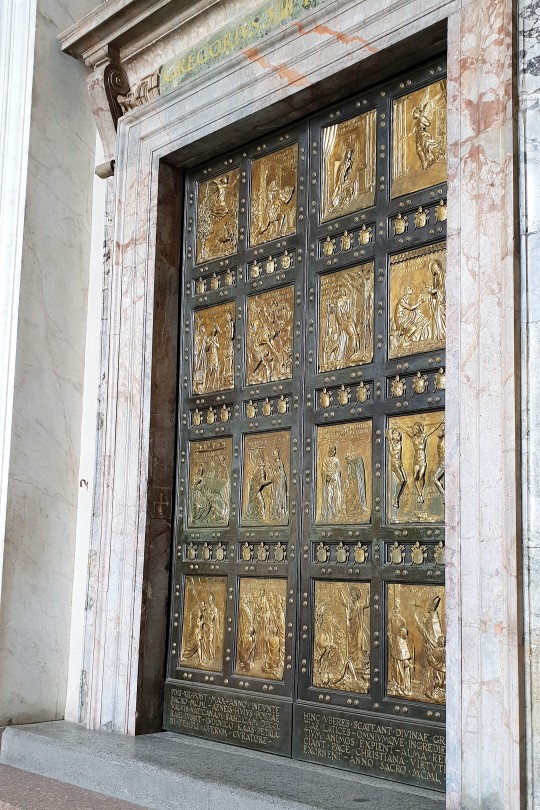
On the first day of a Holy Year, the Pope strikes the brick wall with a silver hammer and opens the Holy Door to the pilgrims.
The first stop inside, and a very popular one, was the Pieta, one of the great religious works carved by Michelangelo over five hundred years ago, depicting the Virgin Mary holding the body of Christ after he was released from the cross. An equally interesting spot was further down the front, past many other treasures to near the altar. As far as Shane was concerned, an equally interesting spot was right down the front where Ewan McGregor self combusted at some stage in some famous Tom Hanks movie. It was a no go area though.
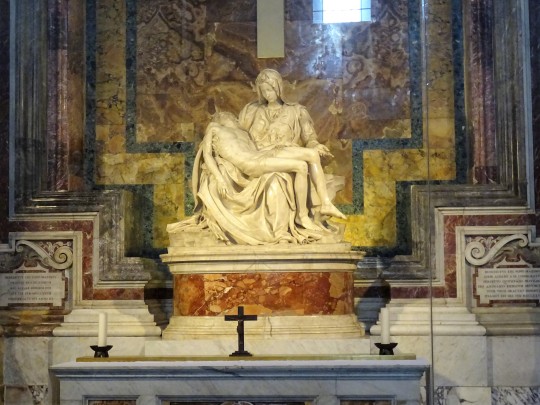
The Pieta, the only signed sculpture by Michelangelo. Not unlike Palestrina Pietà in Florence. Now behind glass due to some nutter taking to it with a hammer years earlier
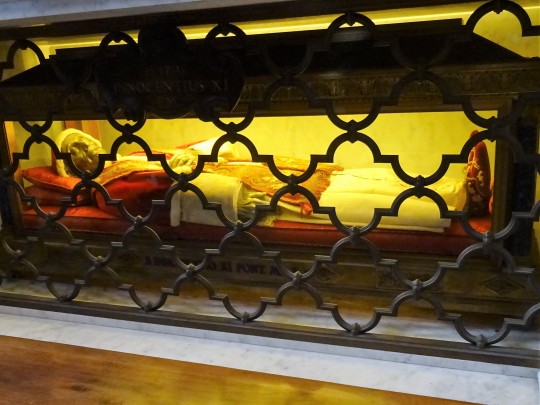
Old mummified pope
Following the guide around the place, we ended up almost where we started, suggesting the tour was finished, but there was one more treat for us. She talked to someone in the know and ended up leading us down a tight staircase to an area within the foundations of the joint and to where many former popes were buried. We were warned that within this area no photos were permitted so we obliged by only taking a few.
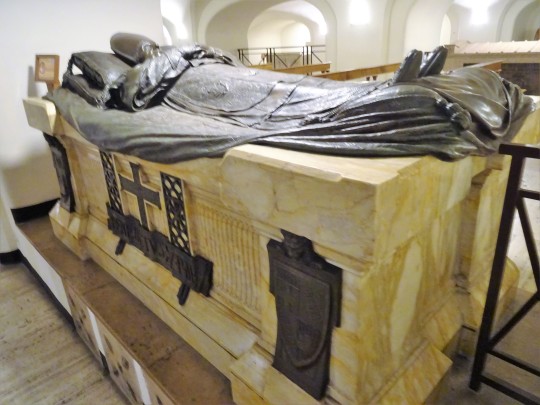
Tomb of Benedict XV, Giacomo Della Chiesa, from Genova
Upon leaving through Death's Door, we hooked a right and checked out the shenanigans of the Swiss Guard. This dedicated and deadly security force that is charged with protecting the Pope could easily be underestimated given their clown suit outfits. But don't be fooled. The Swiss Guards have been the "Defenders of the Church's freedom" ever since a hundered and fifty of them passed through the Porta del Popolo and entered for the first time the Vatican, where they were blessed by Pope Julius II. It was right on twelve so the changing of the guard was underway. That was it. Tour over.
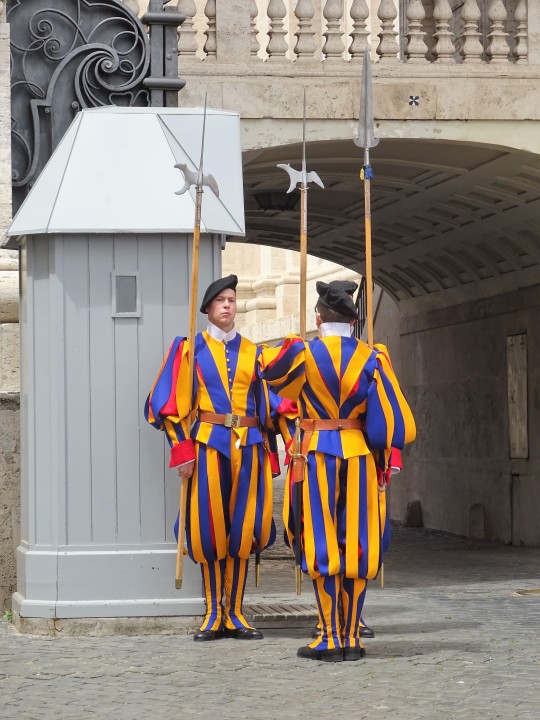
Changing of the Swiss Guard. Defenders of the Church's freedom
Upon exiting Piazza San Pietro and keeping to the southern colonnade, we walked along via della Conciliazione and sat down at the entrance to Parco della Mole Adriana. Once the women caught up, Cecilia was thinking of her stomach again and insisted on finding a restaurant somewhere to eat. Shane and the boys chose a panini from Gastronomia, a food van parked nearby. For a few euro instead of many they were fed, and within a few minutes instead of many. With the time saved they joined the short queue for Castel Sant'Angelo, the Mausoleum of Emperor Hadrian come fortress come Papal apartments. Jo and Cec looked for lunch.
Mausoleum Hadriani was built between 128 and 139 by Hadrian for Hadrian, his adopted kids and their adopted kids. Up until the rule of Emperor Nerva, Roman emperors' ashes were all put inside the Mausoleum of Augustus but the monument filled up. With no room left he had no choice but to build his own, not as big as Augustus's though. Cassius Dio wrote, "He had lived sixty-two years, five months and nineteen days, and had been emperor twenty years and eleven months. He was buried near the river itself, close to the Aelian bridge; for it was there that he had prepared his tomb, since the tomb of Augustus was full, and from this time no body was deposited in it." Nerva's successor, Trajan, was buried under his column in Forum Traiani leaving Hadrian out on a limb. Hadrian died in 138 leaving it up to his adoptive soon Antoninus Pius to finish the job.
One hundred and thirty years later the mausoleum was incorporated into Rome's Muri Aureliani, the defensive walls begun by Emperor Aurelian and converted to a fortress, protecting Hadrian's ashes and his descendants until the Visgoths and King Alaric sacked the joint in 410, thereby seeding Rome's demise over the coming decades. Hieronymus, commonly referred to as Saint Jerome, in a letter to Principia wrote, "My voice sticks in my throat; and, as I dictate, sobs choke my utterance. The city which had taken the whole world was itself taken."

Hadrian's Mausoleum come papal residence
As the boys paid and moved into Ambulacro di Bonifacio IX, an annular corridor of darkened walkways encircling the main structure within and bounded by the protective rectangular walls, founded on the original square base of the mausoleum, fragments of ancient statues lined the path which eventually led to the diametral ramp. This passageway was cut through the monument as part of the fortifications but halfway up was a substantial chasm based with earth and rubble, originally the sepulchral cell below. A nineteenth century iron bridge now breaches the gap, replacing the long gone drawbridge constructed almost five hundred years earlier.
They had reached the second level of seven and at the rear of the structure, walking along the ramparts that linked all four bastions, and the first stop was to look around the area from above, passing a sentry box attached to what was said to be the armoury, a building modified by Pope Clement X Altieri during the late sixteen hundreds. The armoury at the top, prisons in the centre and powder deposits at ground level (could have been trouble if the prisoners escaped), all located adjacent to Bastione San Luca , at the northeast corner of the castle.
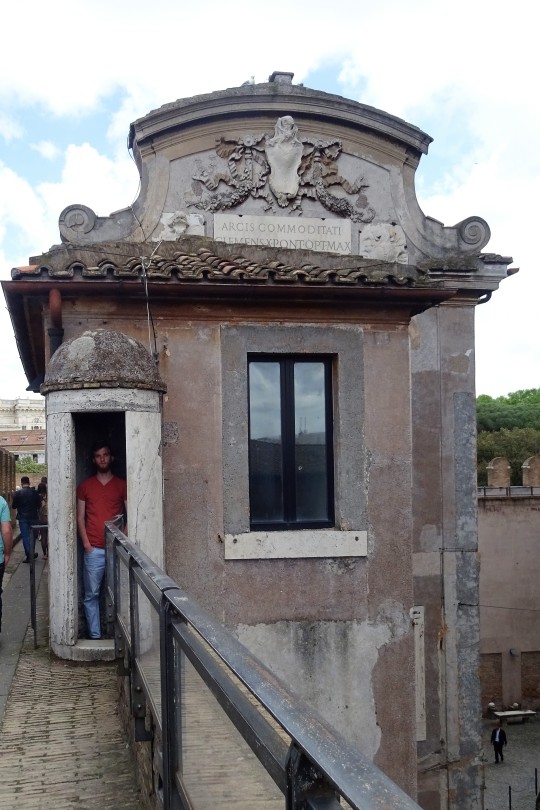
Armoury of Clement X. Notice the curvilinear tympanum and two lateral volutes above
Moving back toward the Tiber, the next bastion, Bastione San Giovanni was the next of the polygonal bulwarks, within which the gunboats were located. This one also had a small representation of a sixteenth-century gunsmith's workshop.
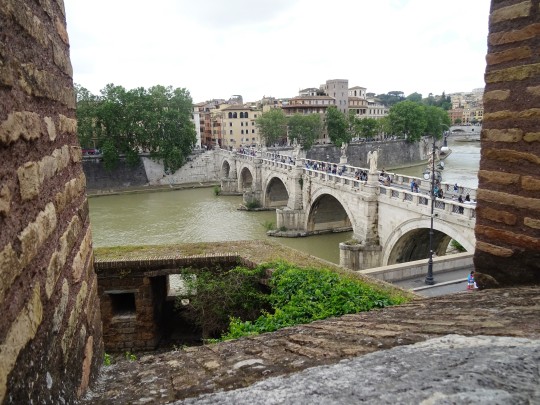
Ponte Sant'Angelo from Bastione San Giovanni
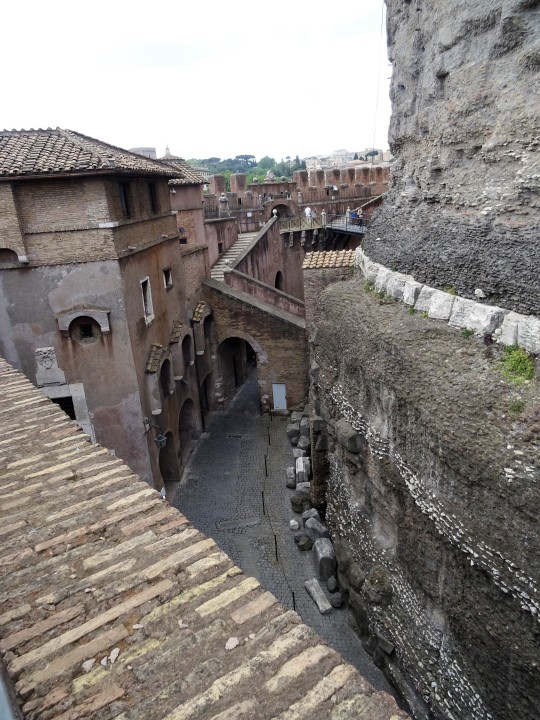
A small section of the "march ronda". The marching rounds refer to the walkway around the top of the walls that link the bastions where sentinels would march and lookout while on duty. Suppose they were continually marching around

Cordonata of Paul III, leading up to Level 3. Busts of Hadrian and a togate in the niches halfway down
Level three contained the historical prisons. Three to be exact and were effectively built underground as the only light came from an opening to the level above. One of the cells hosted the celebrated Renaissance sculptor and goldsmith, Benvenuto Cellini (remember Perseus with the Head of Medusa in Loggia dei Lanzi). He was a passionate craftsman, draftsman, soldier, musician, artist, poet and braggart. You name it he was good at it. He was also good at doing time, repeatedly prosecuted for sodomy, theft, and murder. He done time here for about a year and escaped after getting wind of the pope going to lop off his head for one of his crimes. The pope put it off though due to Corpus Domini in 1538. Getting wind of what was about to happen, he escaped with outside help but was recaptured and relocated in a more secure area, a cell and large cistern for water. Complaining of the tarantulas, poisonous worms and also of the fact that there was "a lot of water " must have done some good as he died many years later in Florence.
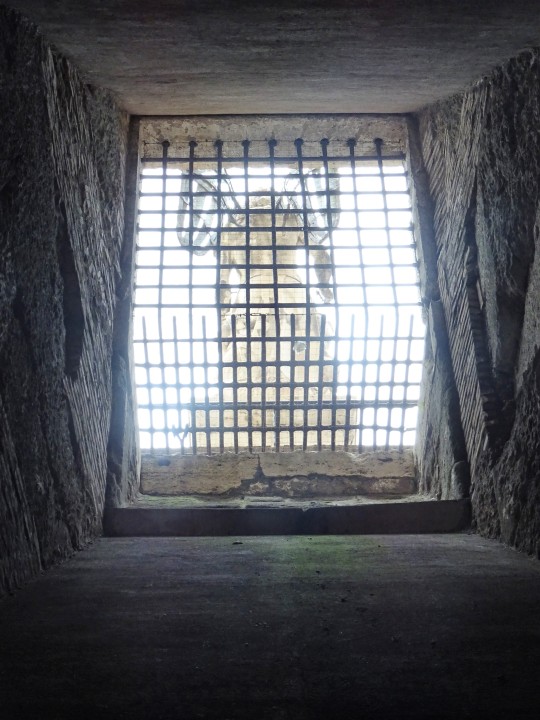
Sunlight from Cortile d'Onore above
The next level consisted of courtyards and linkages to the papal apartments. Cortile d'Onore was the first one that was visited, dominated by a marble and bronze statue of Saint Michael the Archangel after whom the castle was dedicated. This courtyard was bounded by the armoury to the outside and the rooms of the papal residence behind Saint Michael. On the other side of the papal rooms, the Courtyard of Alexander VI joined the off limits Courtyard of Pope Leo X.
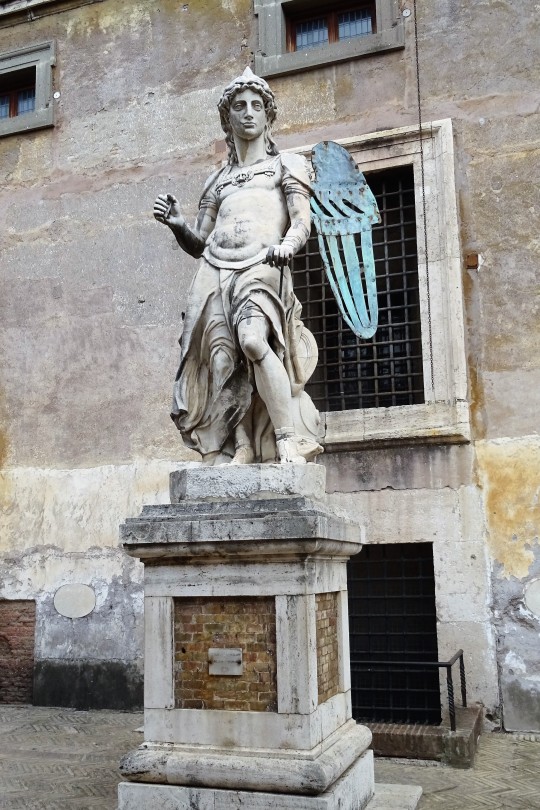
A weather worn Saint Michael the Archangel. It sat atop the fortress until 1747 after exposure to the elements got the better of it
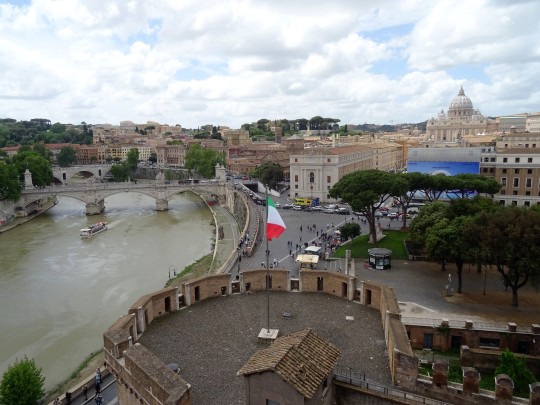
Overlooking Bastione San Matteo and the Tiber
It was then up to the Giretto of Alessandro VII, a walk around the periphery and above Cortile d'Onore. There were several places of interest there. Firstly the Armoury, consisting of four rooms which had displays of military uniforms, weapons, armour and other military memorabilia and secondly the café where we could have a rest and have a beer. The terrace café was quite popular with most tables for more than two taken. There was an impressive view across the city available from several tables as well but the stiff cold breeze explained why. A table was bagsed out of the wind and a reintroduction to Saint Stephanus was made. Not since Caffé Pitti all those days ago in Florence did the two meet.
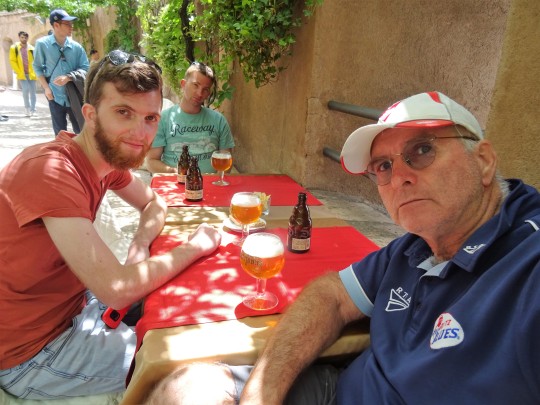
Rest time at Caffetteria Ristorante Le Terrazze Castel Sant’Angelo
Meanwhile, not impressed with just a panini, Cecilia took Jo and went in search of "proper" food, heading off through some alley ways where they finally settled in at the little café, Panico Ristorante Pizzeria just across the Tiber. Cec could now have what she had been yearning for ages, an authentic Italian pineapple pizza.
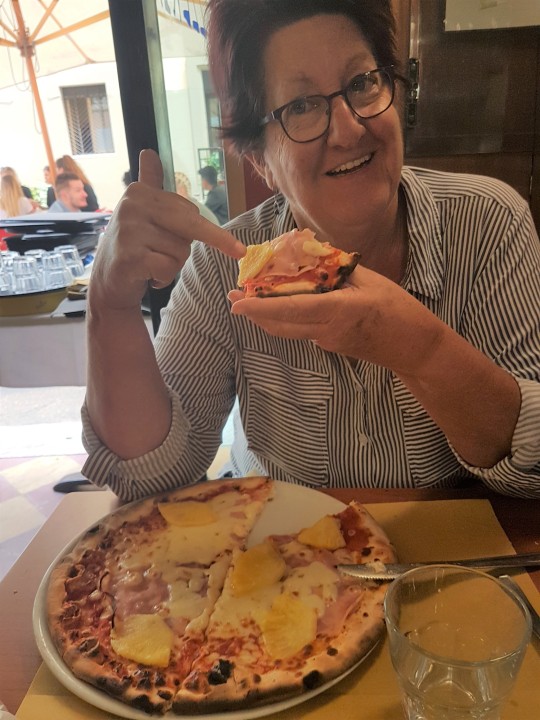
Mmmm….. She finally got her pineapple pizza
When the breeze was braved the Roman roofscape was on offer. Looking out the embrasures allowed a view of Bastione San Marco and the Passetto di Borgo, the protected walkway that shielded the Pope as he made his way between the Vatican, some eight hundred metres to the west and Castel Sant'Angelo. It paid for itself in spades during the Sack of Rome of 1527 when Pope Clement VII Medici and his entourage fled to the safety of the fortress through Passetto di Borgo while the remnants of a massacred Swiss Guard Unit held off the attacking Habsburg soldiers of Emperor Charles V. The rest is history.
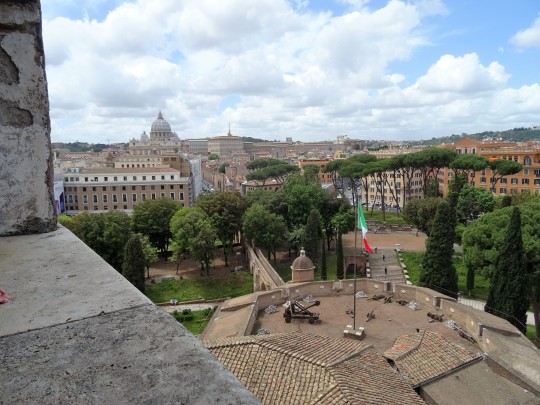
Bastione San Marco and the Passetto di Borgo leading off to the Vatican
After the break the men pressed on to the papal accommodation and associated rooms. Keeping to Giretto of Alessandro VII and moving clockwise, they found themselves within Loggia di Paolo III, built during the mid fifteen hundreds and overlooking the area to the north and west. Overlooking Prati and out to Monte Mario, and over towards the Vatican area. Adjacent to the loggia was the entrance to the private apartments of Paolo III Farnese.
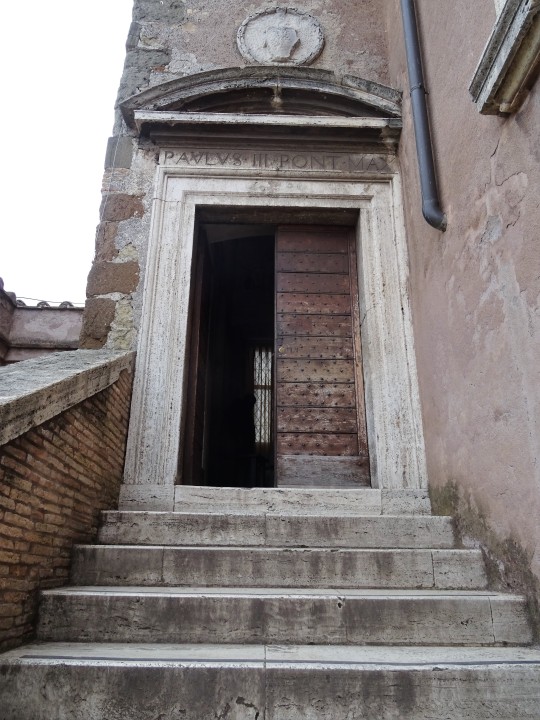
Welcome to the mad house. Door to the Pope's pad
Over the threshold, a right turn, and they were in what was once one of the most protected areas in the fortress, Sala della Biblioteca and Sala del Tesoro where the Archives of the Papal States and the Secret Archive and other documents were stored as well as the treasury and other precious objects. Sala del Tesoro was a round room utilising the original roman central tower of the mausoleum, secured by two closed doors and only opened with keys held by the Pope's Secret Treasurer and the Cardinal Dean.
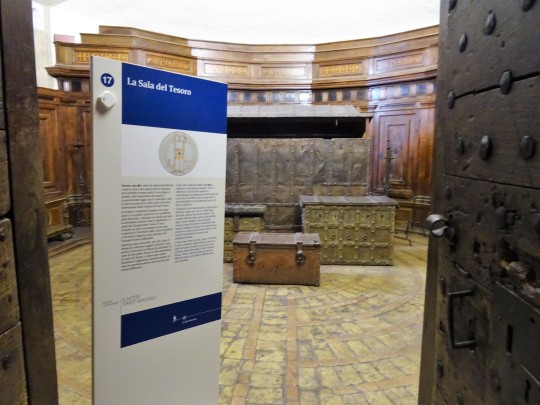
Sala del Tesoro. The "treasure" was held in the large iron treasure chest, only accessible through the opening of six locks. The keys entrusted to different people
The seventh and last level consisted of a couple of small rooms, one of which contained some sort of modern type art. Sala Rotonda was located directly above Sala del Tesoro and was created by building a floor to separate it from the room below. Originally a chapel, around sixteen hundred it was utilised for storage of the secret papal archives that the Sala del Tesoro couldn't handle. These documents took the name of the "Old Archive". Sala delle Colonne was built in the mid seventeen hundreds to house the "New Archive". Two smaller adjoining rooms, Saletta dei Labari dei reparti d’assalto and Sala degli Stendardi della Cavalleria were decorated in patriotic war themes, after World War I and intended to hold Italian war relics.
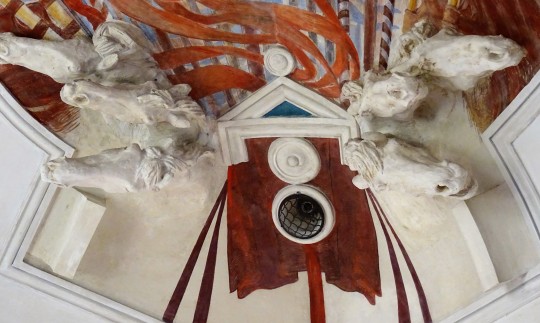
Sala degli Stendardi della Cavalleria, horse head ceiling decorations
They were finally at the top of the fortress, overlooked only by the Statua di San Michele Arcangelo perched on high, sword drawn from his sheath as if protecting all from those who would dare to strike. The archangel also overlooked the terrace that had been the scene of the Girandole, the fireworks that, for hundreds of years marked pontifical elections and religious or city celebrations (after ensuring that the shutters on the Sala Rotonda windows were well shut). The terrace also provided a beautiful view of the surrounding city, from the Vatican Museum to the west, across the Tiber and to the Mausoleum of Augustus to the east. After some time enjoying the scenery, it was time to move back down to pick up what they missed on the way up.

Terrazzo dell'Angelo. Archangel Saint Michael has been overlooking the terrace for nearly 270 years

Basilica di San Pietro from Terrazzo dell'Angelo
Retracing their steps somewhat, dropping a couple of levels and moving counter clockwise through the Revolution and rooms of Pius IV, they moved through the Giretto displaying Hadrianic fragments from the original mausoleum and to where they were a bit earlier, the Loggia di Paolo III. A set of stairs leading to Cortile di Alessandro VI in turn led to impressive papal rooms including Sala Paolina, Sala del Perseo and the Sala di Amore e Psiche, culminating in a collection of arms at the Armerie and the Sale di Clemente VIII.
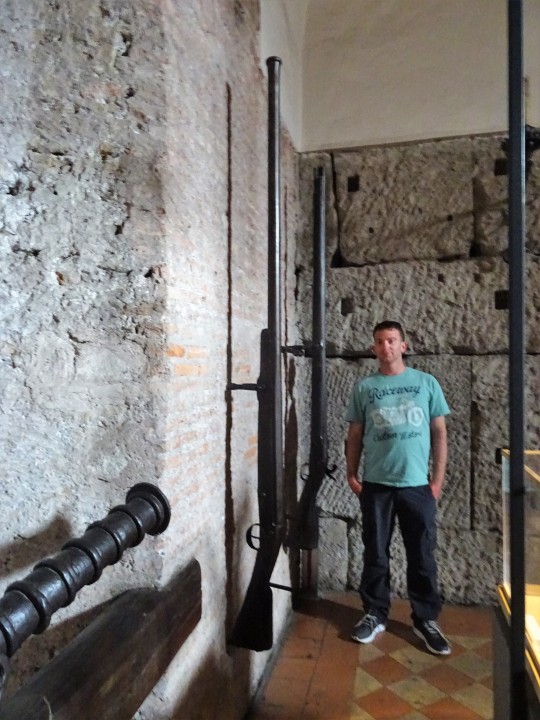
Big weapon
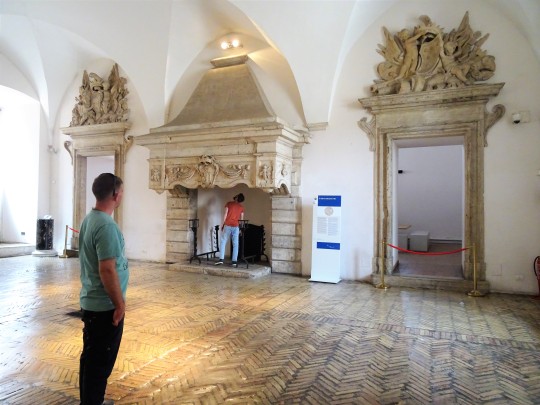
Sale di Clemente VIII and the monumental fireplace decorated with the heraldry of the Barberini, family of Pope Urban VIII. The doors either side came along a bit later
That was it. Exiting through Sala di Apollo, the exit was made via Rampa elicoidale to the Dromos e Atrium. The helical ramp, built around the time of Trajan and Hadrian and significant with the funeral procession and the emperor's last journey, was sealed during the sixth century for defensive reasons. It wasn't dug up again until the early eighteen hundreds.

The helical ramp leading out
The ramp ended out onto the street to some extent, so heading back down through more tunnels and walkways to a section that would have been below water when a moat existed, remnants of the fortresses past with architectural bits and pieces positioned in rooms and in varying stages of decay appeared. The rooms also had scale models of the fortress depicting the different constructions over the centuries. This display should have been in a more prominent place. The end was nigh, everyone exiting Castel Sant'Angelo very satisfied with the effort. This place was money well spent.
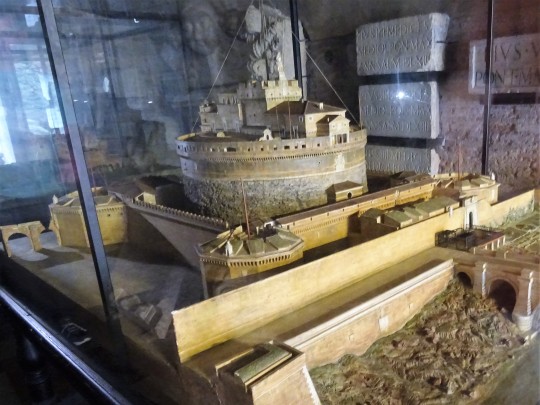
Model of the castle
By mid afternoon it was time to return to the apartment via Piazza Navona and the Temple of the Nymphs along via delle Botteghe Oscure. Upon arrival, energy was being expended on washing clothes. Jo and Cec had had their afternoon nap, were catching up on some chores and preparing for the soon to be, Trastevere Food Tour.
Shortly before six, we jumped into a cab and were duly dropped off across the Tiber from Piazza di San Bartolomeo all'Isola, the meeting place and where the tour would commence. It was a little after six when we headed off to the first restaurant due to one couple being a few minutes late. There were the five of us, two other Aussies and four Yanks.
Crossing the Tiber again, our group were taken through a few side streets until we were in Via dei Vascellari and shortly after outside of Da Enzo Trattoria. From the roadway we were given a piece of advice. We were eating before the evening rush hours of the restaurant as later on it was so popular that it was always booked out, and as such there was plenty of room so we were shown inside and introduced to the owner (or just the waiter). The two courses that stood out was the Carciofi alla Giudia (fried artichoke) which had the centre removed and deep fried, positioned upside down in the middle of the plate and covered in a sprinkling of olive oil, salt and pepper. An apt choice given that the meal is Jewish in origin and we were in the Jewish Quarter. The other was a delicious serving of Burrata cheese, served as a ball of what looked like runny, lumpy yoghurt covered in a mozzarella skin. We could have had more of that.
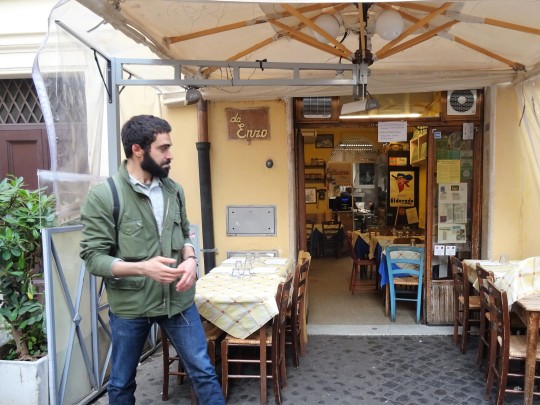
Da Enzo on Via dei Vascellari
Next was a trip through the narrow streets to Restaurante Spirito di Vino a short distance away. The front door was on Via dei Genovesi where we entered the last time but this time went through a side entrance from a side lane, Vicolo dell'Atleta. This took us straight down the stairs to the basement to sample some wines and morsels. The building itself was extremely old but where we were served, cavernous ancient cellars were B.C. type old. The room was quite dark with wine racks covering some of the walls, bottles covered in a healthy layer of dust. The mood wasn't dark though, everyone loved it.
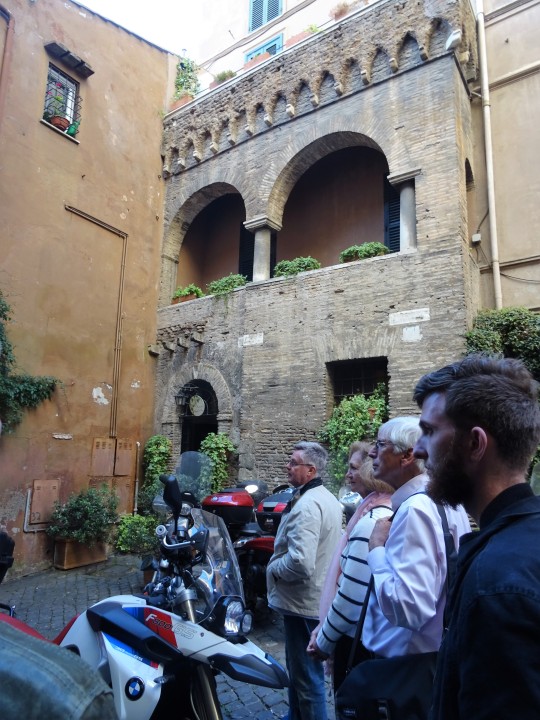
Restaurante Spirito di Vino side entrance

Ancient cellars of Spirito di Vino

Cheers, big ears
After the experience at Restaurante Spirito di Vino and on the way to the biscuit shop, the guide pointed out a distant Santa Cecilia. Declaring her interest, Cec suggested that we drop in their in the coming days for a look. After all she was named after Saint Cecilia. Years ago Cecilia's mother had piano lessons as a young girl, taught by the nuns at the convent. She hated the lessons but loved the paintings of Saint Cecilia that hung on the wall near the piano.
The biscuit shop, Biscottificio Artigiano Innocenti was on Via della Luce.

We were sat down here and given samples of their produce. The Brutto ma Buono (translation-ugly but good) made from sugar, egg whites and nuts was particularly nice so we took a bagful with us.
Then given the opportunity to work off the biscuits with the hike to the next place, we moseyed onto the delicatessen, Antica Norcineria Iacozzilli, porchetta being their specialty. The slow roasted pork was nice and juicy within and crispy without. Three generations have made it so.
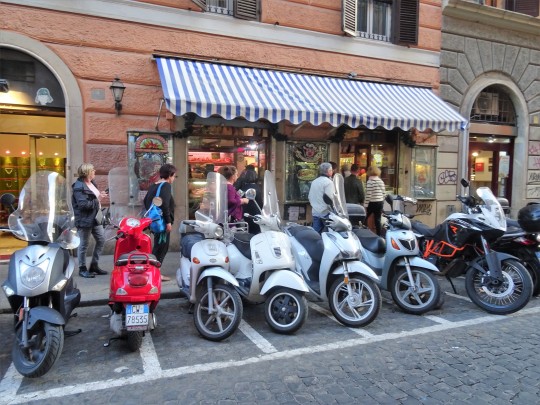
Antica Norcineria Iacozzilli
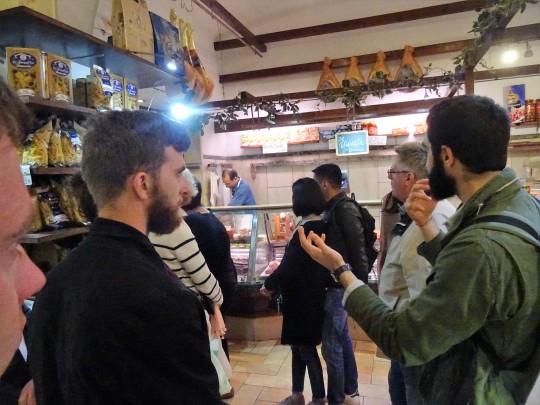
Waiting for the porchetta
Then the hole in the wall on Via di San Francesco a Ripa. The I Suppli sell takeaway suppli only. Once you buy the risotto, marinara and mozzarella egg shaped rice balls, take them outside and eat on the footpath. As we did.
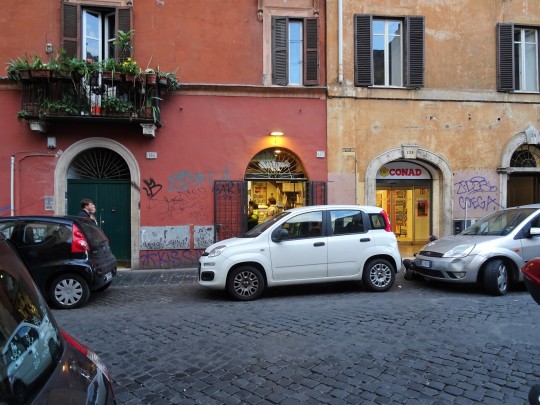
Rice ball heaven
Another long walk then ensued, onto Casa Mia in Via della Renella. Our guide stopped for a while at a church in Piazza di Santa Maria called Basilica di Santa Maria in Trastevere. This place, we were told held the head of Saint Apollonia, the Patron Saint of dentistry who had her teeth smashed in by an unruly mob some time back. They then built a fire to burn her but she jumped in before they had the pleasure of throwing her in. Bits of her are all over the place in European churches.
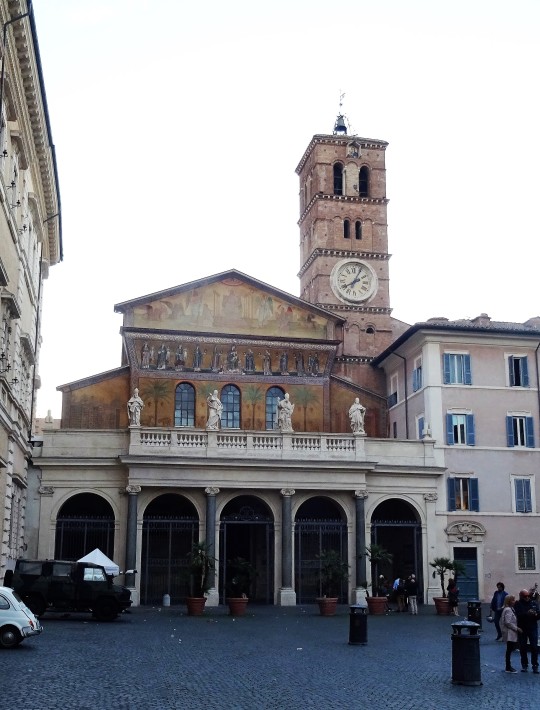
Basilica di Santa Maria in Trastevere holds the head (probably toothless) of Saint Apollonia as well as a couple of holy men. Pope Callixtus I and Lorenzo Cardinal Campeggio
Then to Casa Mia on Via della Renella.
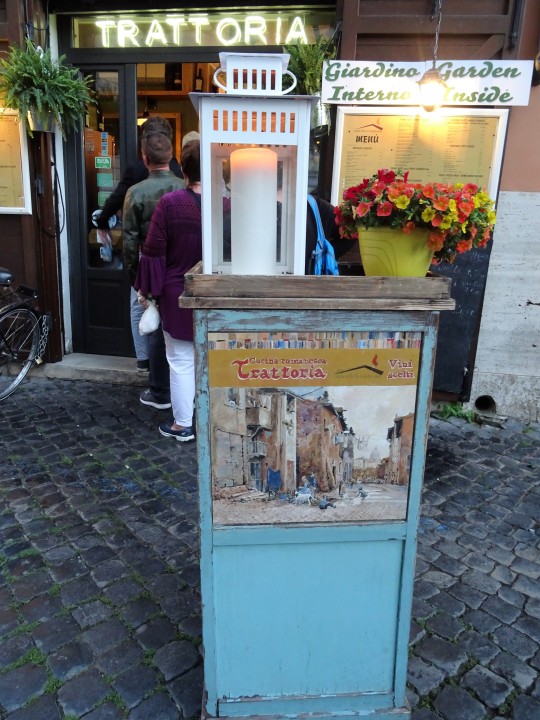
Plenty of pasta and plenty of wine was consumed here
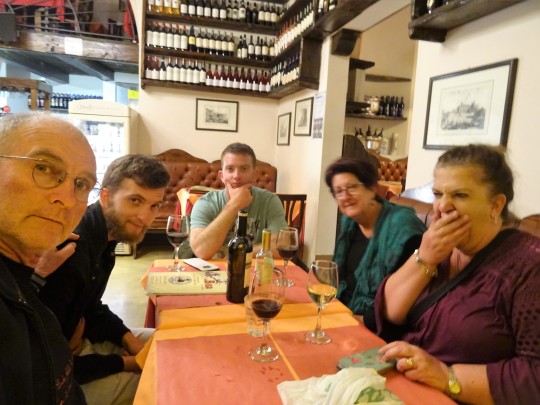
The conversation must have been a bit boring. For Jo anyway
To finish off, it was back across town to Fatamorgana ice cream shop on Via Roma Libera. The gelato here wasn't the fluffy stuff in the tourist areas. It was fair dinkum gelato, characteristic of the natural colouring that would be expected if nothing artificial were added (we eat all types).
With gelato gone, we said our goodbyes to the other foody tourists and headed to the nearby taxi rank. Tomorrow, Cec and the boys are booked into the Coliseum. Jo and Shane will tackle Forum Romanum.
0 notes
Text
Roma v’s Juventus
13/05/2018: It was a late start today as it was a late one last night and another late one expected tonight, watching Juve v Roma at Stadio Olimpico.
We had nothing planned so we wandered out the front door, veered left and kept to the footpath until reaching the traffic lights at the eastern end of the Coliseum. Straight across the road was Rome's foremost training academy for gladiators, Ludus Magnus. Built by Emperor Domitian in the late first century, the complex was just one part of a wider public building project undertaken by the Flavian emperors, however its closure came about five hundred years later when gladiatorial contests were abolished. Although only part of it was uncovered, it was enough to get a perspective of its size and layout. We weren't part of a tour but there were tours in the grounds. Still, a quick look from the top to appreciate the ruins was plenty.

Part of the Ludus Magnus, gladiator school with a tunnel linking it directly to the Coliseum. The rest is still buried under the streets and buildings
Negotiating the traffic was our first challenge for the day, negotiating the beggars on route to our next destination was the second. They were everywhere and driving us nuts already. Keeping the Coliseum, Arch of Constantine and Forum Romanum to our right, our next stop was along Via di San Gregorio and also to our right, Circus Maximus. Located in the valley between the Palatinus and Aventinus, another couple of Roman hills, the chariot circuit was apparently built during the sixth century B.C. by Tarquinius Priscus, the fifth king of Rome. Also apparently, it was while these races were underway at some point that the rape of the Sabine women occurred. The Sabine men were so engrossed in the races that the Roman men abducted their unmarried women to be their wives. Good story anyway.
We were at the round end, the square end was quite a distance away. Over half a kilometre where the chariots would enter the stadium twelve at a time, six on either side of the entry that led from the Forum Boarium. Sitting above the entry was the presiding magistrate who would be either a praetor or consul and started the race by dropping a white starting flag. We were overlooking the sweeping curve or sphendone where the Arch of Titus was located and where the processions would pass through to enter the arena. There's not much left now but some remnants of the arch's columns are still around. The complex once held well over a hundred thousand people but was now a grassed over reminder of the power of the Romans.
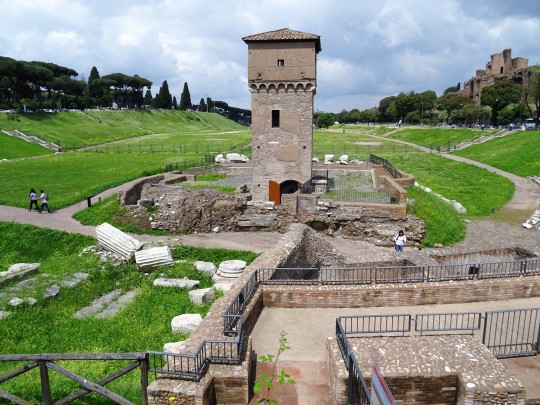
The tower of Moletta, a medieval water mill built after the Circus Maximus became farm land. The remains of another Arch of Titus bottom left. It was part of the original complex through which processions entered the arena
Down at the other end of Circus Maximus, near where the chariots would have entered was void of anything at all. The dirt track adjacent and parallel to Via di Cerchi, toward the square end of Circus Maximus (where all the chariot prangs apparently happened) led us there but we couldn't get all the way as it was blocked off, forcing us to move onto the footpath due to tents having been erected for the eighteenth Komen Italia Race for the Cure (breast cancer), due in five days’ time and filling up the end of the stadium.
It was then down to a busy and confusing area where traffic came from everywhere and cars parked all over the place. This was Forum Boarium where the chariots would have come from to start the races. To cross the main road we had to walk a bit to a pedestrian crossing (not that it's any safer), crossed Via Luigi Petroselli and walked up Via dei Ponte Rotto, behind the Temples of Portunus and Hercules Victor and across the Tiber via Ponte Palatino.
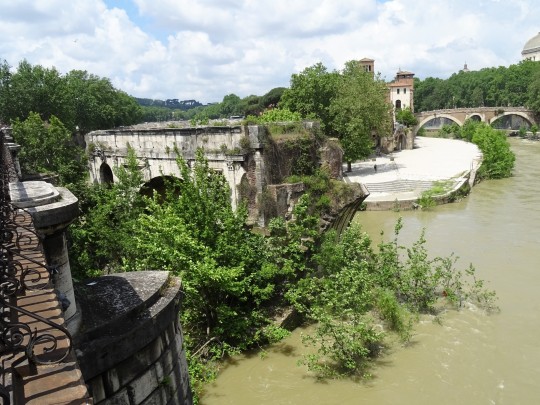
Ponte Rotto (Broken Bridge) was known by several different names during its existence. It kept collapsing and every time it was rebuilt it was renamed. All but one span was demolished to build the current bridge. Tiber Island and the oldest bridge in Rome, Pons Fabricius in the distance

Coat of Arms of Pope Gregory VIII, pope for two months in 1187 was still there
The Tiber was interesting to say the least. Walking along the western promenade afforded a lovely view of the murky water and weir that ponded the murky water under Ponte Cestio, creating eddies that trapped litter and vegetation in what seemed to be a state of perpetual motion. The fascination of the spinning pollution soon became tedious so moving towards Ponte Cestio, we crossed the bridge and familiarised ourselves with Piazza di San Bartolomeo all'Isola where we would meet the guide for the food tour tomorrow. We then crossed the oldest Roman built bridge still in use, Pons Fabricius. The bridge was built during the first century B.C. linking Campus Martius and the Theatrum Marcelli to Tiber Island, named after its builder, Lucio Fabricius and adorned by two very weathered herms with four heads, hence its nickname, Ponte dei Quattro Capi.

Lvcivs FABRICIVS Cai Filivs CVRator VIARvm
FACIVNDVM COERAVIT EIDEMQVE PROBAVIT
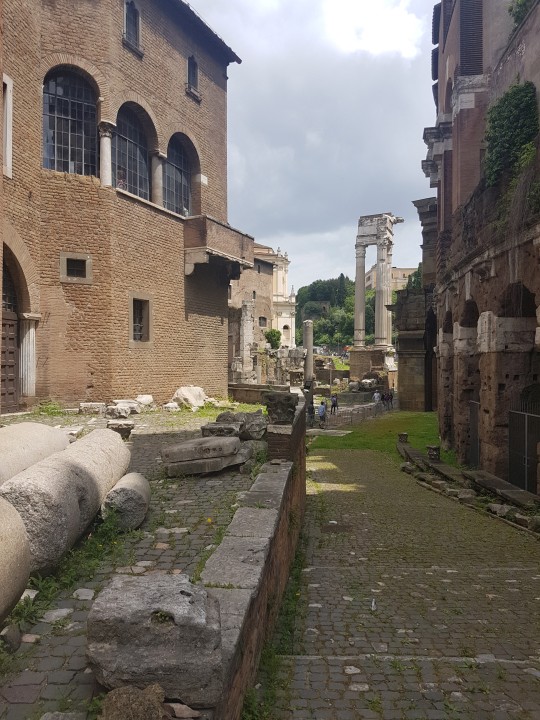
Temple of Apollo Sosianus at the back. Theatre of Marcellus to the right
Heading up Via del Portico d'Ottavia, we were looking for a feed. It was after one and everyone was hungry. The entire street was packed with tourists with not much room alfresco. We ended up getting a table at Il Giardino Romano up against the front of the building. The food filled a hole but was expensive and somewhat ordinary.
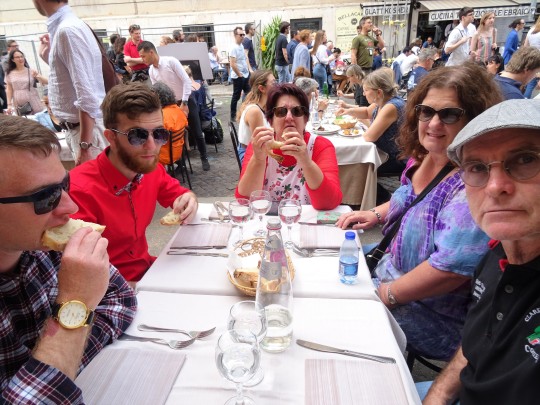
Lunch at Il Giardino Romano. Tourists a plenty
With filled bellies we headed further along until we turned into Via Arenu'a and found a confronting reminder of the past. As we had encountered in Berlin a few years ago, a couple of brass plaques were imbedded into the footpath representing a couple of locals who were long gone. They were local Jews who would have been rounded up by the Fascists and sent off to the camps. They didn't muck around neither as they were transported fifteen hundred kilometres to Auschwitz and gassed within a week of their detention.
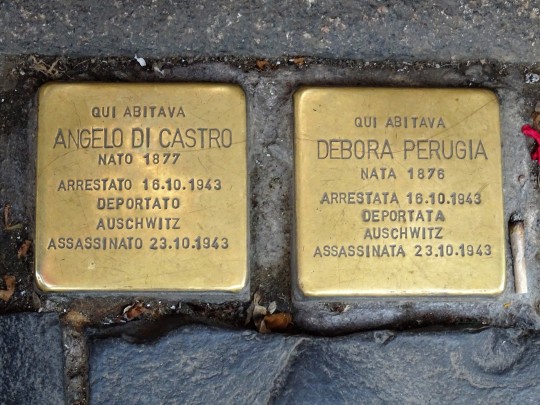
Just as in Berlin, the footpaths recognise Jews who were marched out of their houses to meet an early demise. This time it was Angelo and Debora's turn
On that depressing note we moved on and almost immediately came across Largo di Torre Argentina, named after a character from Strasbourg which at some time carried the Roman name Argentoratum. The ruins contained Roman Republican Temples and the remains of Pompey's Theatre. They also contained a few too many cats, although one cat is too many, and someone to feed them from a room within the ruins at the southern end. Tom and Beau were quite interested in them. But most others weren't.

Temple B, dedicated to Fortuna Huiusce Diei
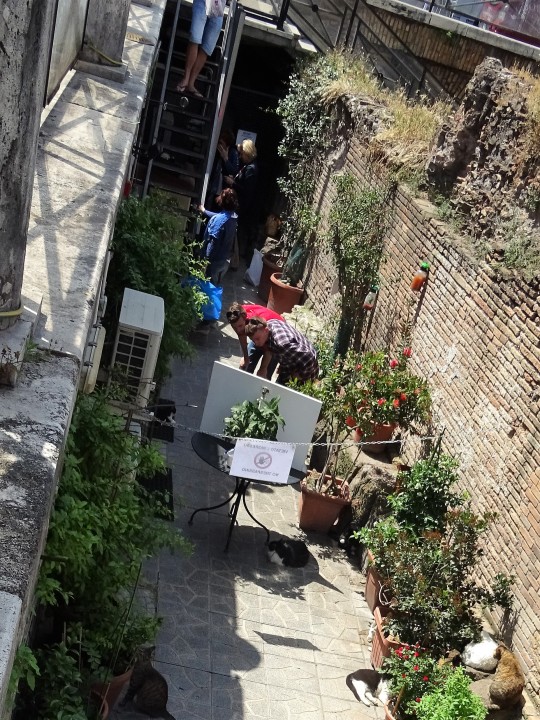
Here Kitty Kitty. The Torre Argentina Cat Sanctuary
Piazza Navona was a few streets away and our next stop. The area was filled with all sorts including faceless clowns and mimes but we particularly enjoyed the buskers, old guys playing stringed instruments and entertaining all who would get involved. There were also the usual Africans trying the usual and plenty of artists selling their stuff. At the other end of the piazza were more stalls and Fontana del Nettuno. Beyond the fountain was a short lane that led to gelato and a rest.
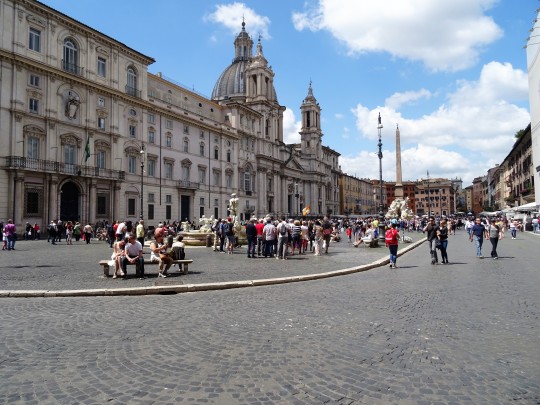
Piazza Navona, ex chariot track
Soon after zig zagging through a few more streets we entered Piazza della Rotonda just near Fontana del Pantheon. The place was packed from where we entered through to the queues waiting for entry into the Pantheon.
Monumental complexes and such started to spring up in this area following Octavian's (soon to become Emperor Augustus) victory over Marc Antonio and Cleopatra at the Battle of Actium off of the coast of modern day Preveza in Greece. The victory occurred in 31 B.C. and was effectively the final battle of the Roman civil war of the Roman Republic. From there on Octavian became Augustus, the first emperor of the Roman Empire. One of his initial projects was his magnificent Mausoleum, followed by the Pantheon a few years later. What we see today is a radically altered Pantheon constructed by Hadrian during the early second century.
There were as many people as expected. Several horse drawn carriages trying to entice tourists into a ride had to manoeuvre through the crowd by using their size, albeit politely. Queueing up with the crowd wasn't too bad as the lines moved fairly quickly but once inside the crowds were just as bad. Everyone going about their business, admiring everything and kinking their necks, looking up at the imposing dome and the equally imposing oculus well above. While we were there a mass was getting underway. It must have been difficult to perform but the priest was probably used to it. A rope barrier only allowed entry to the fair dinkum worshippers.
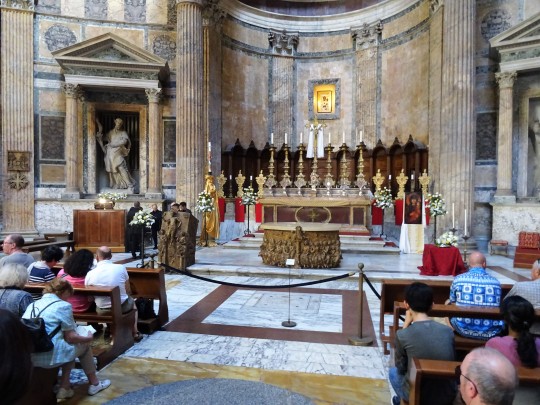
Chapel of the Pantheon
Back outside though, Tom and Beau were focusing on other matters. The old fella cutting prosciutto off the bone near the entrance to the salumeria.

Mulling over whether to buy some salumi
Trevi Fountain was next. Not being exactly sure where it was, we followed the crowd and the obvious narrow laneways that led a path to the again, crowded monument. Unlike most other monuments in Rome, the Trevi Fountain and Spanish Steps are quite recent, eighteenth century in fact which is almost new by Roman standards.
Everyone was taking their selfies and as crowded as it was we could still squeeze through to access the lower and closest tier and manage to grab some seating. Then, Cec goes down, flat on her arse on the worn and uneven marble steps. We sat her down for a while until she recovered somewhat and then hung around and enjoyed the atmosphere for a while, as much as we could anyway. Then, down a side street for food, across Via del Corso and further on to GiaRoma1886. It was quite hot but we chose al fresco so Cec could have a vape, sitting on the footpath across a small laneway where the waiters would carry our tucker whilst looking out for traffic. We were in the shade so it was quite comfortable bar the noise. GiaRoma1886 was a pretty good restaurant. It gave the appearance of being small on the outside but upon entry was quite large and well set out on the inside.
We then separated. Jo, Shane and Tom towards Piazza Picolo while Cec and Beau headed back to base.

Trevi Fountain
From there Piazza del Popolo was our focus and the tram stop beyond the gate. Several stops along the way were necessary to watch the street artists, some extremely good like the hip hoppers and the dude with the glass balls and others a bit strange. One that come to mind was the person inside the box with hand puppets that would jump out and scare the shit out of people as they walked past. He didn't get us so it was quite funny to watch everyone else's reactions. The final stop before moving through Porta del Popolo and outside of the Aurelian Walls was the Roma football shop. There was plenty to look at inside but we were only looking for something to wear at the football. A cap and scarf for the football and a cheap Roma v Liverpool T shirt left over from the recent Champions League semi final. Liverpool won so they would have been keen to get rid of them.
The tram terminus was straight outside of Porta del Popolo, across a couple of very busy roads and into Piazzale Flaminio. We were a bit early so we headed to Tintori for a quick beer. Plenty of Roma fans meant that there were no seats, they took them all. There were almost as many cops keeping the peace. We stood on the footpath leaning on the underground access to the Metro, drinking beer and enjoying the goings on until it was time to leave. This meant queueing for the toilet in the bar. Even the cops were queueing for a piss so we all headed next door to Burger King. Even they were busy.
Ending up on the tram platform, we just missed out on the next tram but were amongst the first to catch the following. Unlike the last time when we headed to Lazio v Inter Milan, we went a stop or two further on and got off at Piazza Mancini.

Packed like sardines
Not knowing where to head after leaving the tram, we followed the crowd across the Tiber where we found plenty of vendors selling merchandise, food, beer and those shots of coffee that the Italians seem to love. We were right outside of Stadio dei Marmi, a fascist era open air stadium built under the direction of Benito Mussolini to compliment the annexed Fascist Academy of Physical Education. From a distance the arena was surrounded by classical statues but ended up being fake Greco-Roman ones. We grabbed a panini and beer before heading around the entry point and to Curva Nord to take our seats.
The security were much more organised than when we watched Lazio and Inter Milan last time. There was still security and police but it was a smoother entry. Shane still managed to lose his bottled water again at the hands of a police frisking. Once inside there were a lot more kiosks open than at the Lazio game. The only issue was the piss trough cascade that was overflowing all over the floor before the game had even started and only got worse during the night.
Our seats were located a fair way down the concourse and almost behind the goals. We were fairly early but as kick off neared the crowd thickened around us. At first we bought the beers at the kiosk but as the game commenced a team of vendors walked around with beers delivered. They were more convenient and the plastic cups were bigger. A win, win situation.
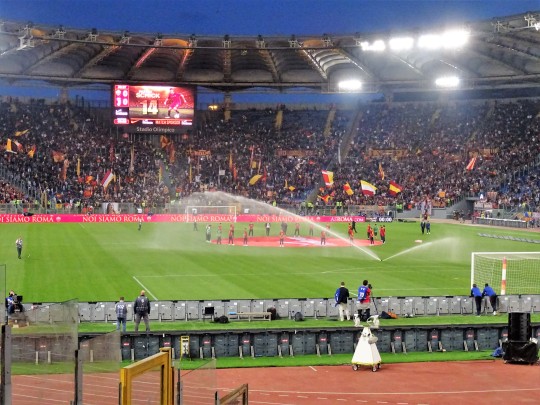
Pre match introductions
The atmosphere was excellent and although amongst Roma fans, we were at the same end as the Juventus fans. A point would have given Juventus the premiership. They were very rowdy and whatever they were chanting, the Roma fans around us would scream an emotional response of some sort. As if they could be understood.
The game ebbed and flowed with chances at both ends. It however ended scoreless which meant that Juventus had got what they had come for, a point. The only team that could have beaten them was Napoli who had won earlier and their score went up, on the score board. Everyone knew what was happening. The Serie A was in the bag.

Post match. Juventus players thanking their supporters
After full time the boys challenged the toilets again and we headed out, walking back across Ponte Duca D'aosta. It was full of vans selling beers and steak sangers. Tom grabbed a largey and we headed off down the street. Not wanting to take the tram home we walked well away from the venue until we hailed a taxi. First thing he said was that the beer had to go. After that it was straight back to the apartment.
It had been a long day. When we had arrived back Cec and Beau had just got back from a session down stairs and were quite rowdy.

A few reds and ice cream to finish the night off
A couple of more drinks and it was bed. Tomorrow an early one at the Vatican.
0 notes